Language Learning Apps, Revisited: 34 Products + Bonus Links
More than three years ago, I discussed a few apps meant to help you learn a foreign language; while I still believe the best way to learn a language is to use printed manuals with audio support, especially the old-style ones that give you competent grammar explanations (for the French readers: Assimil … sans peine, Pocket 40 leçons pour parler …, Livre de Poche … en 90 leçons et 90 jours aka 1 leçon par jour pendant 3 mois, with extra material such as Bescherelle … pour tous, Hatier … de A à Z, where “…” should be replaced by the target the language in the definite article), sometimes technology can help quite a lot, and most people might benefit from the different approaches used in different apps, such as the Spaced Repetition System (SRS). So here I come back with short assessments of some major language-learning apps.
Busuu ■ iTalki ■ Fluenz ■ Memrise ■ Assimil apps ■ Duolingo ■ WordBit ■ HelloTalk ■ Mango Languages ■ HiNative ■ Gymglish ■ Speakly ■ Lingvist ■ reword ■ BeeLinguapp ■ LingoDeer ■ Babbel ■ MosaLingua ■ Rocket Languages ■ Lengo ■ uTalk ■ Tandem ■ Mondly ■ Drops ■ LinGo Play ■ PORO ■ LingQ ■ OptiLingo ■ Glossika ■ 50 Languages ■ Fluent Forever ■ Rosetta Stone ■ Pimsleur ■ Speechling ■ Bonus: YouTube channels ► For French ► For German ► For Italian ► For Spanish ► For British English
Targeting a “rare” if not exotic language severely limits the choice of a helper app, but supposing you want to learn German, Italian, Spanish, Portuguese, French (or maybe Mandarin, Japanese, Korean) and you know very well or your mother tongue is English or French (the second case also limits the choice), there is a bunch of apps available for each language pair. The apps mentioned below were only tested by me for the following language pairs (depending on the availability): from English: German, Italian, Spanish, Portuguese, French; from French: German, Italian. WordBit was tested using Romanian as the native language and Italian, German and English as target languages.
I decided to rank the apps based on an ad hoc bullet system that’s a mixture between a traffic light and a VU meter:
🟢🟢🟢🟢🟢 Busuu
The very first language-learning app I ever tried! Years later, I found it much improved, even when it comes to grammar (which could still be improved though). It can be tedious sometimes, but IMO better structured than Duolingo (also, better pronunciations!). It takes you slowly but surely, and I found it molto simpatico. I explored “Complete Italian” in depth and I liked what I saw in the 98 lessons of A1, the 48 lessons of A2, the 47 lessons of B1, and the 22 lessons of B2. I then checked back with German, which frustrated me back in 2014, and I can confirm that German is, with Italian, among the best of what Busuu can offer. There are two different courses per language, e.g. “Complete German” and “German for Travel”; some languages add a third one, e.g. “Italian Pronunciation” and French Pronunciation”; some add more, such as “French for Business” or “Learn Spanish with El País” (beware that Busuu only teaches the Spanish used in Spain). Note that the app contents matches exactly the browser-based one, which is not the case with Memrise and Duolingo. Does it deserve its position up here? I certainly hope so.
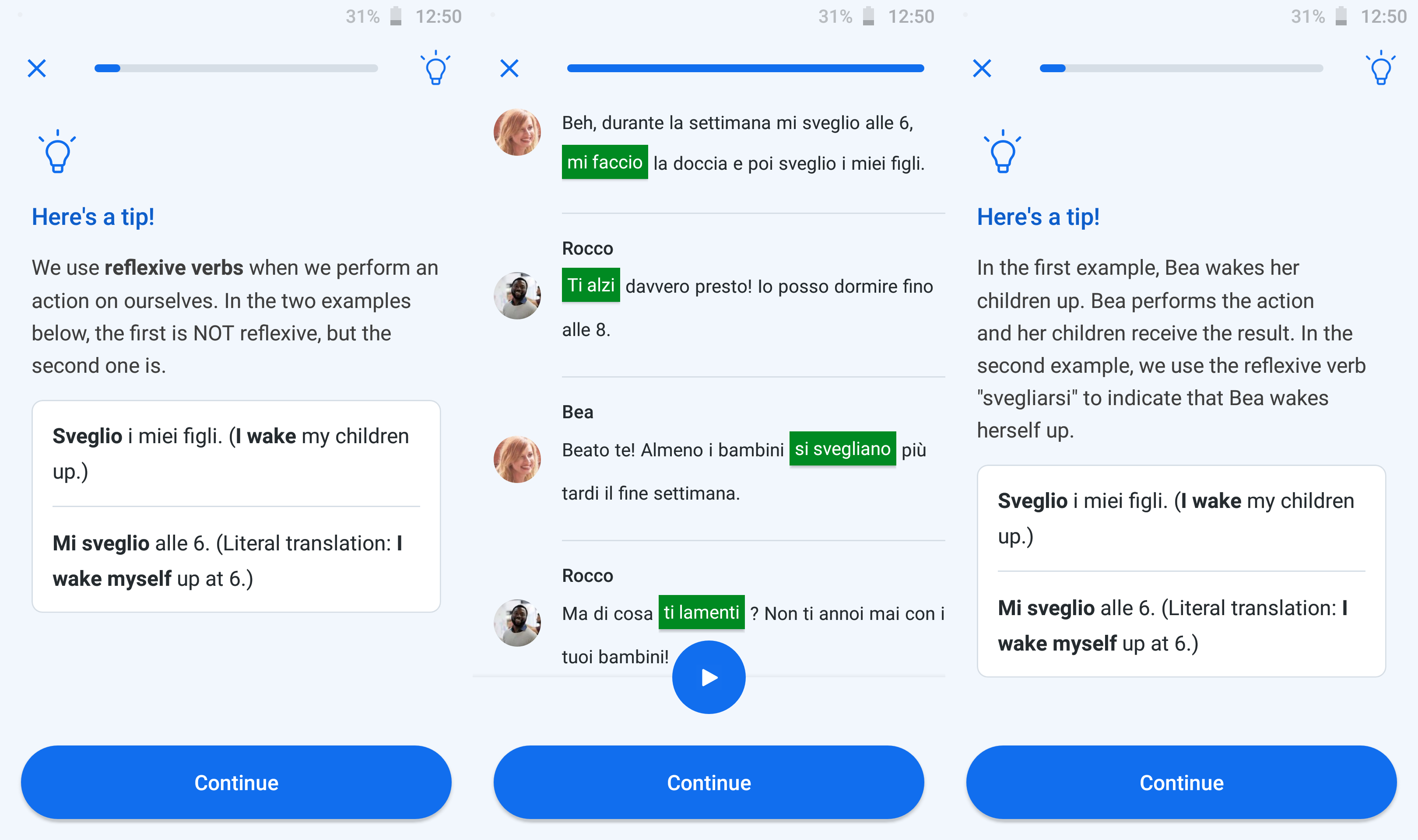

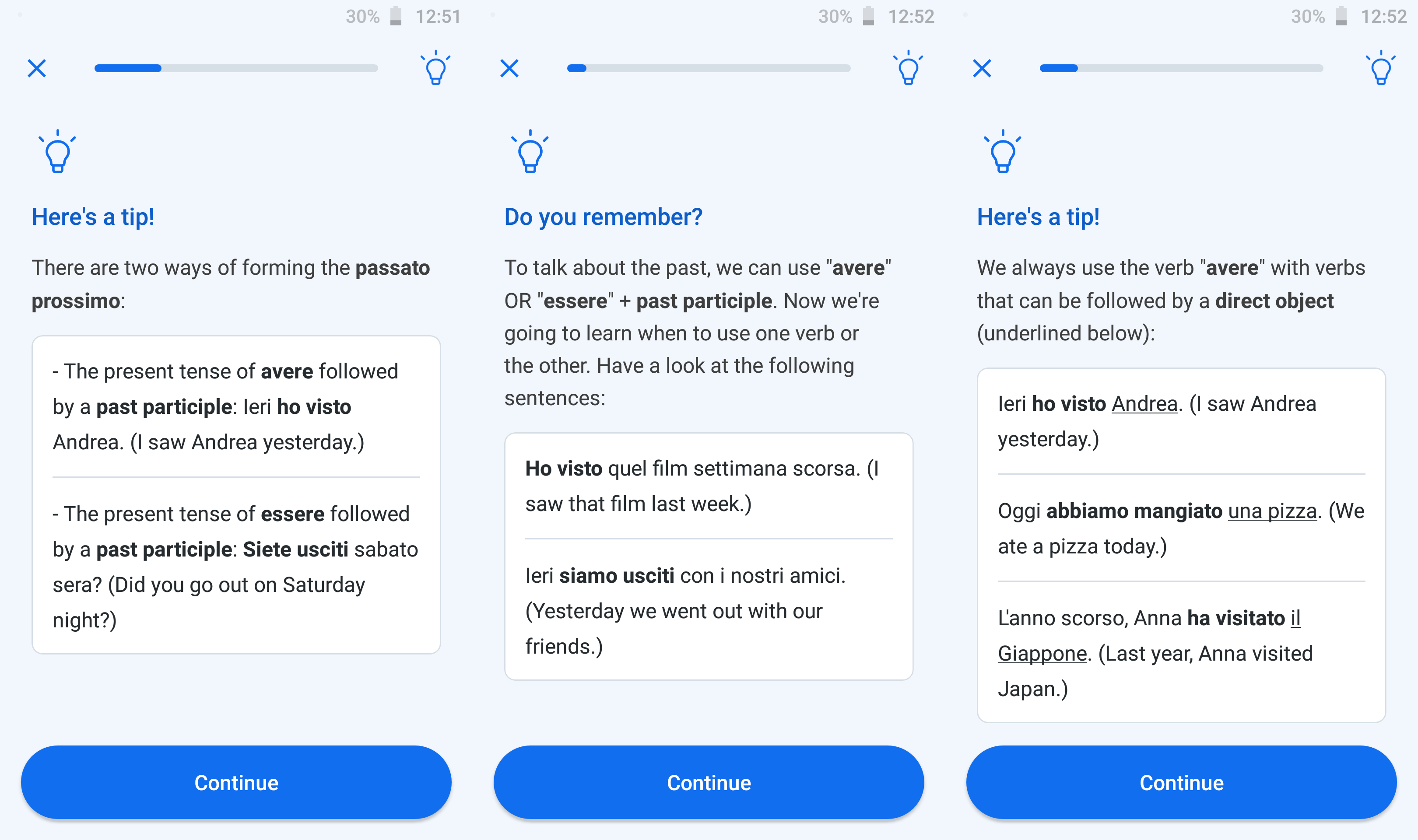
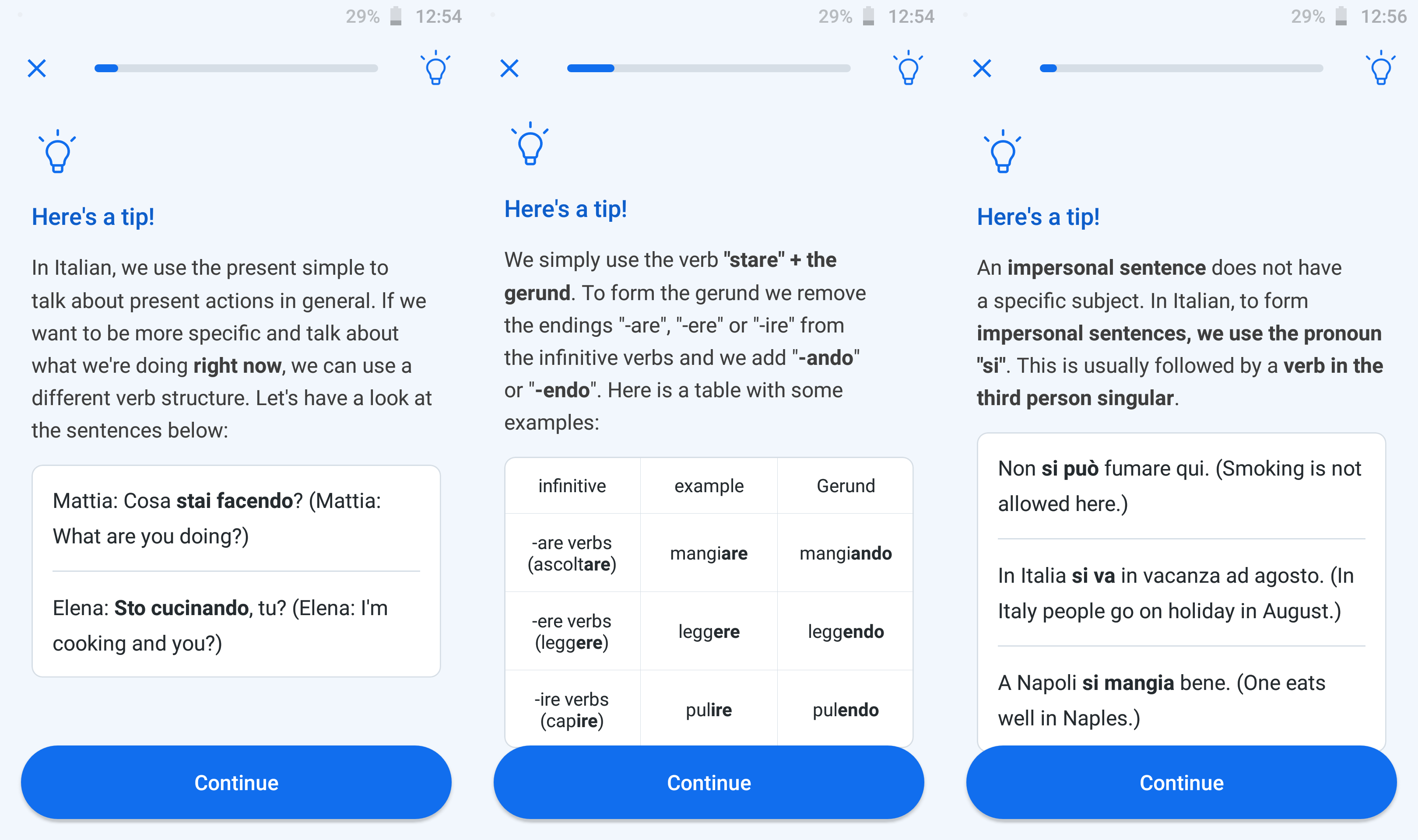
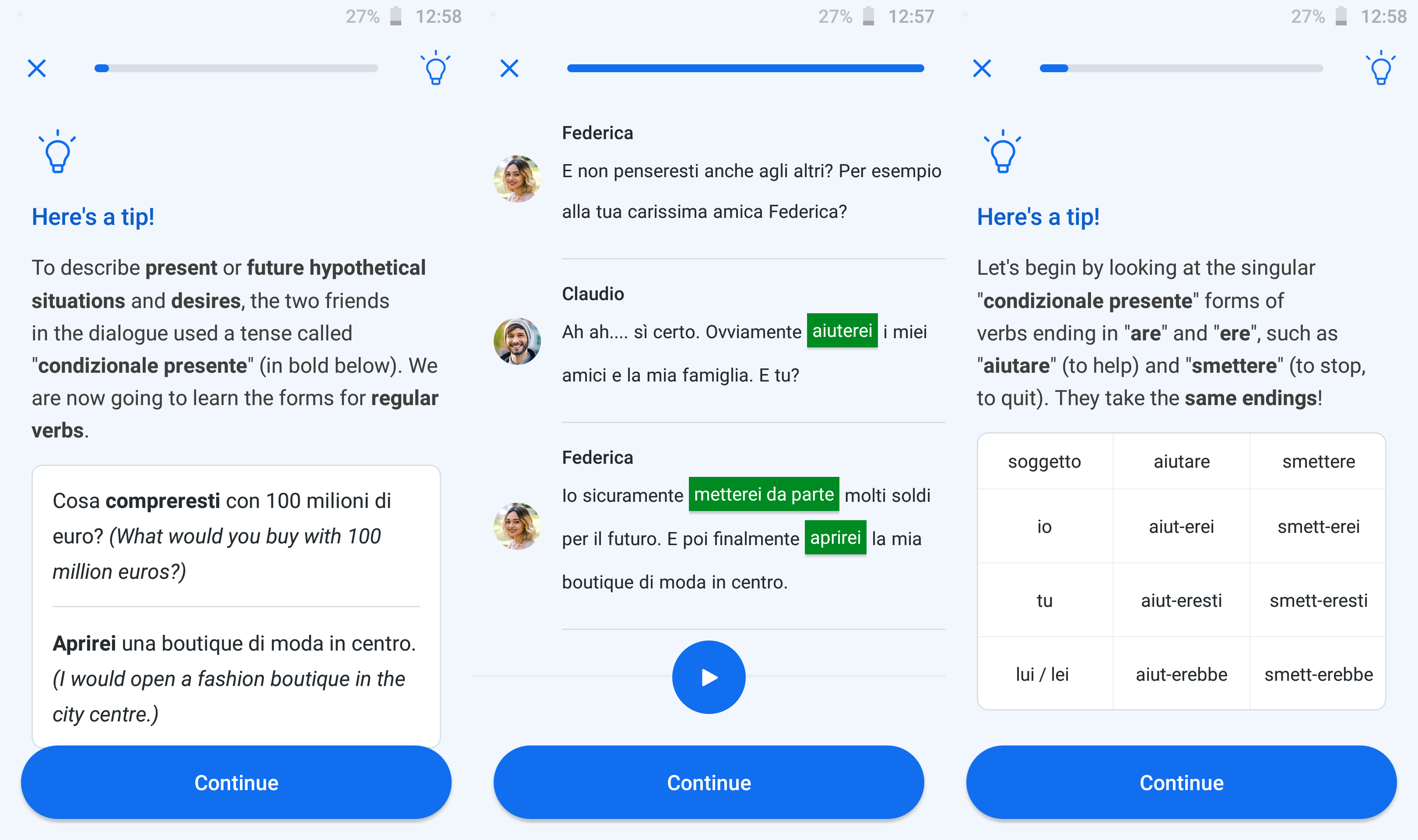
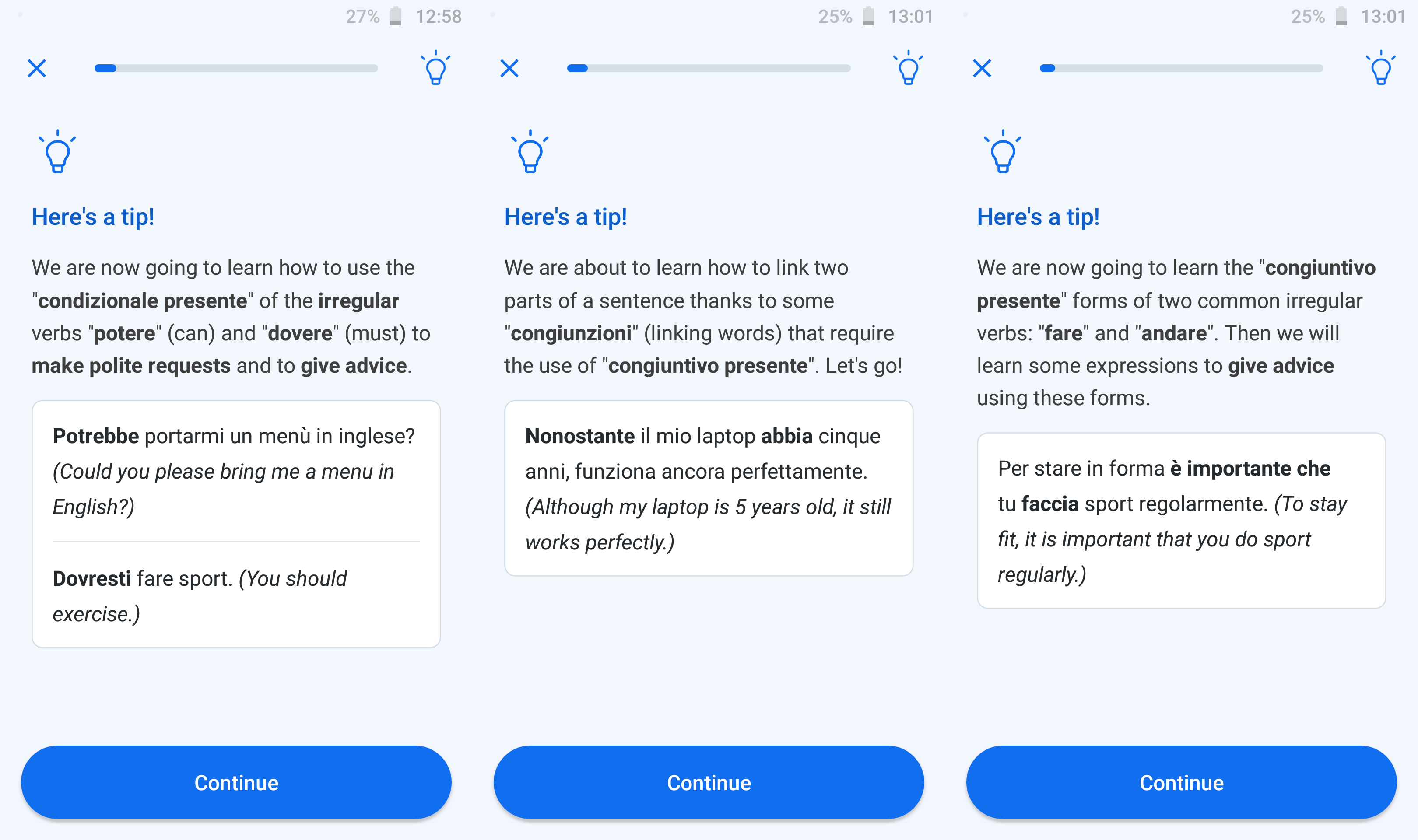
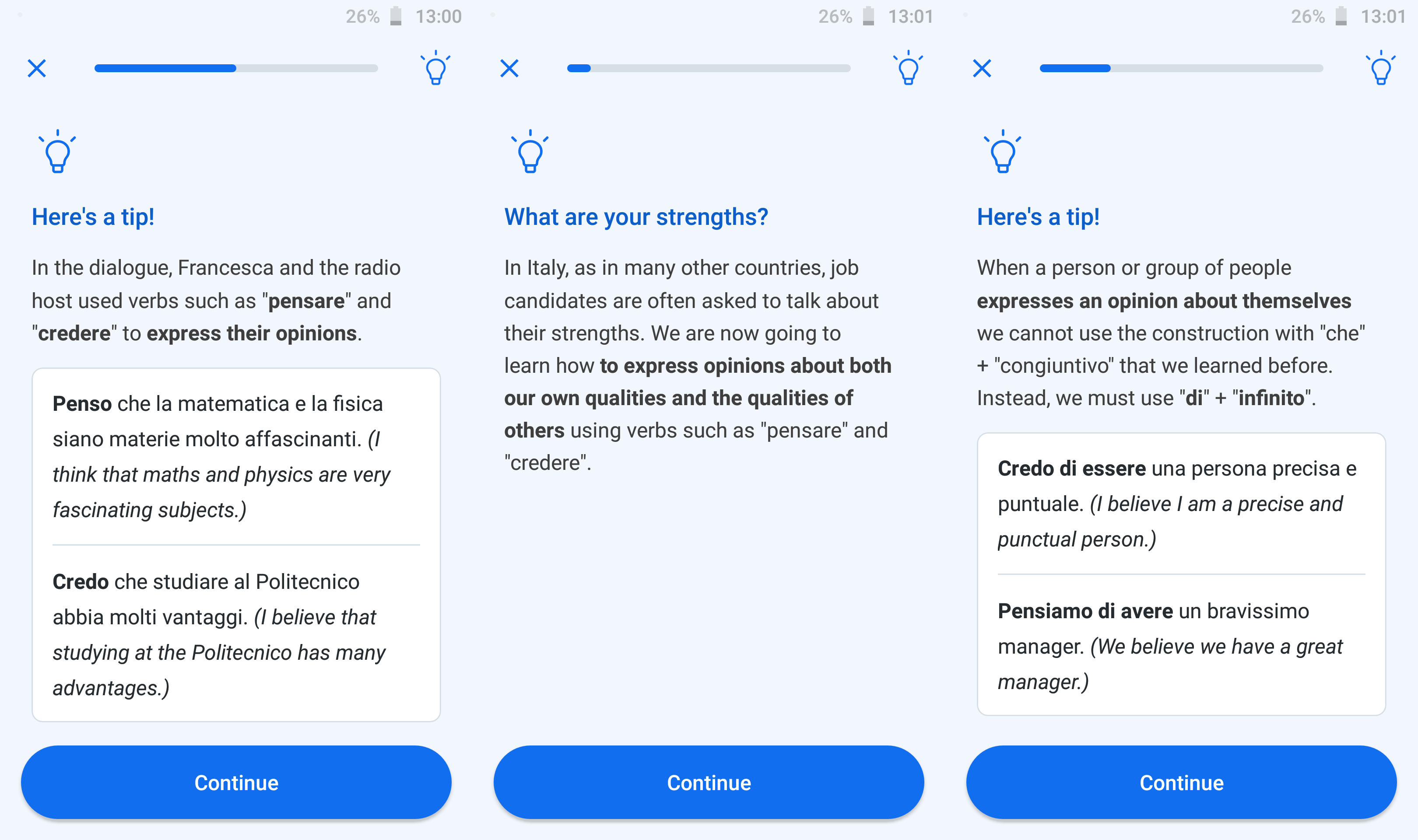
I should add that in most cases, there’s a consistency in Busuu: should you want to learn e.g. Italian or German, no matter you’re doing it from English or from French, the lessons will be the same, but translated and slightly adapted.
By popular demand, and also because generally the reviews in English don’t cover the learning of English itself, I checked the “Complete English” course for speakers of French, and I was very satisfied with the grammar contents.
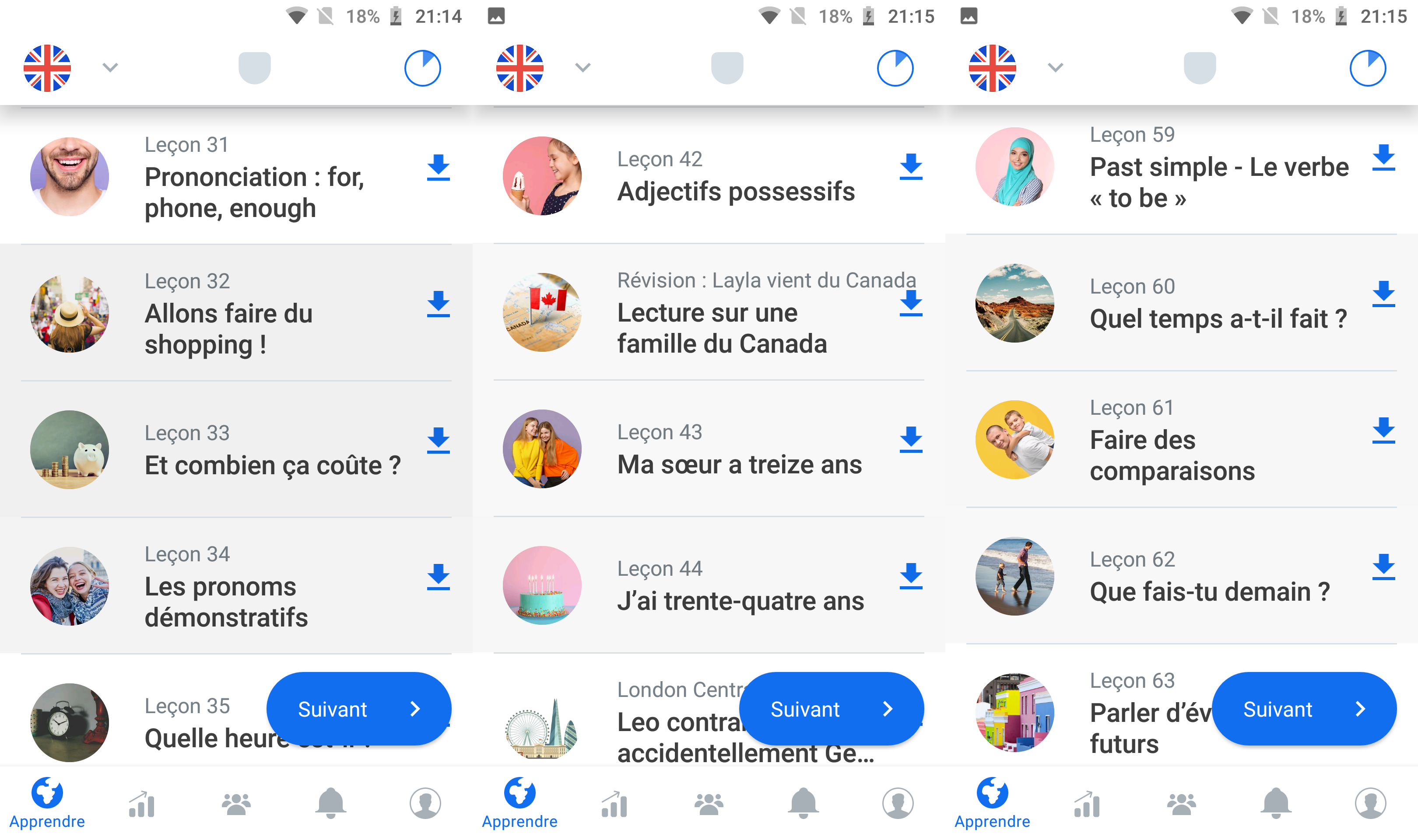
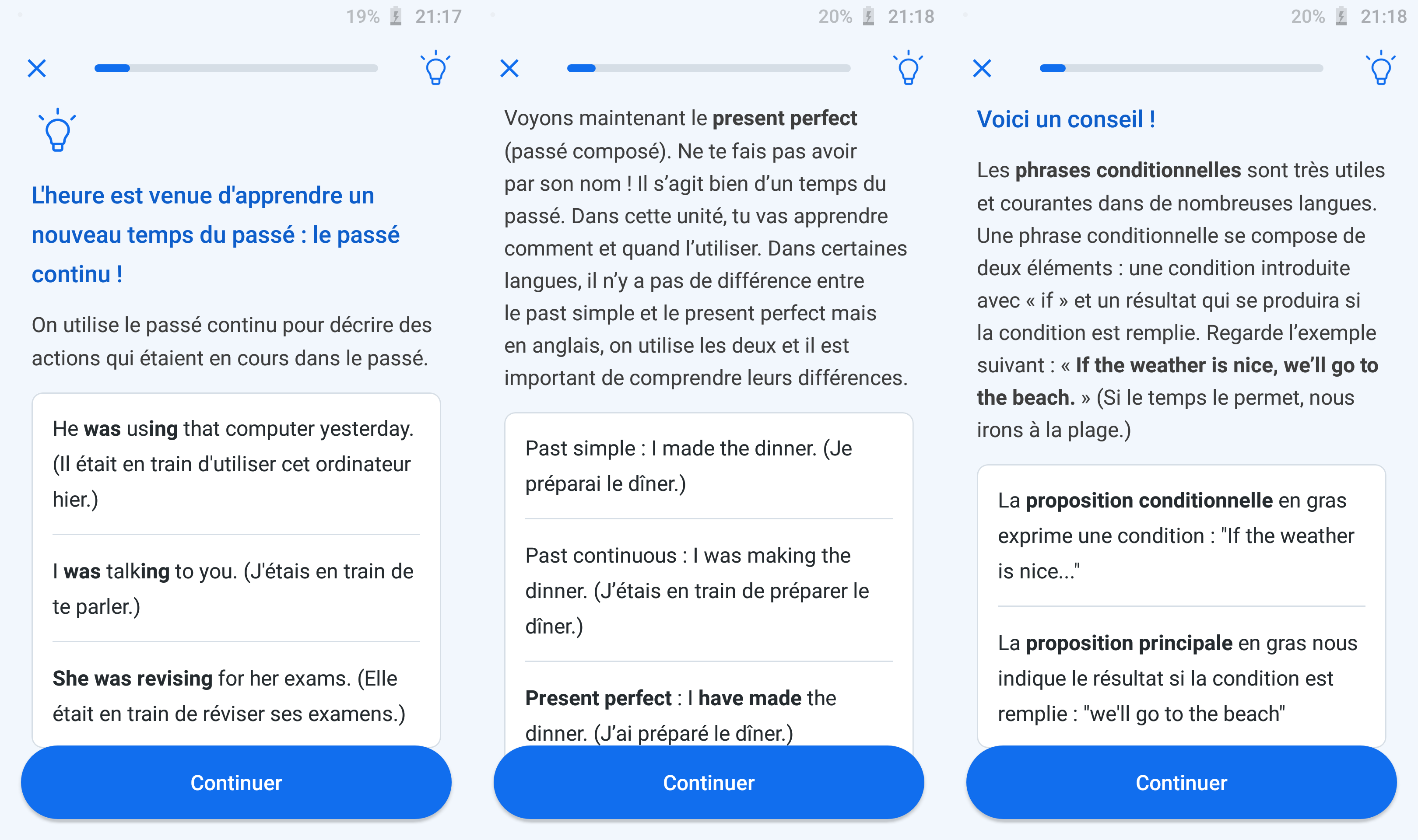
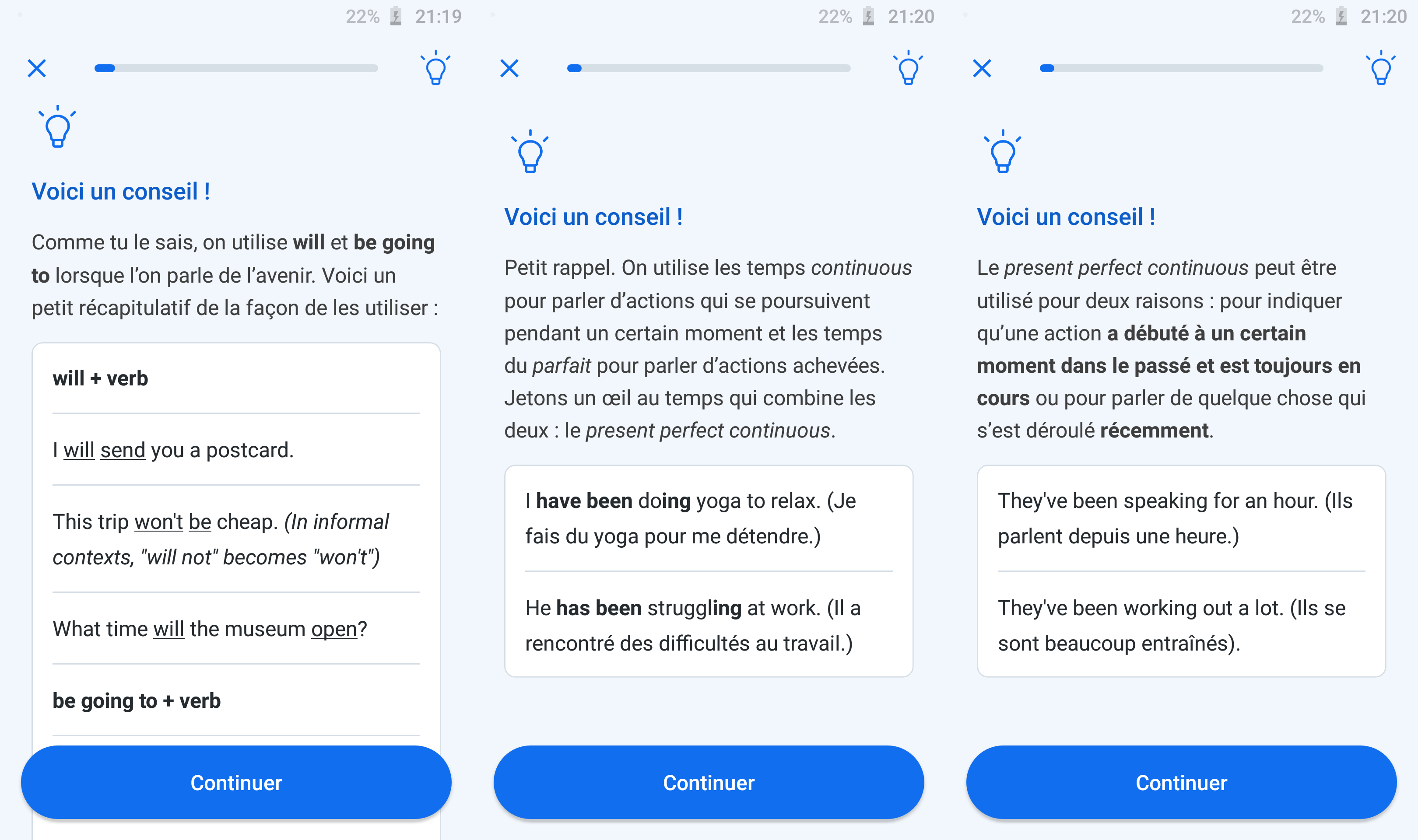
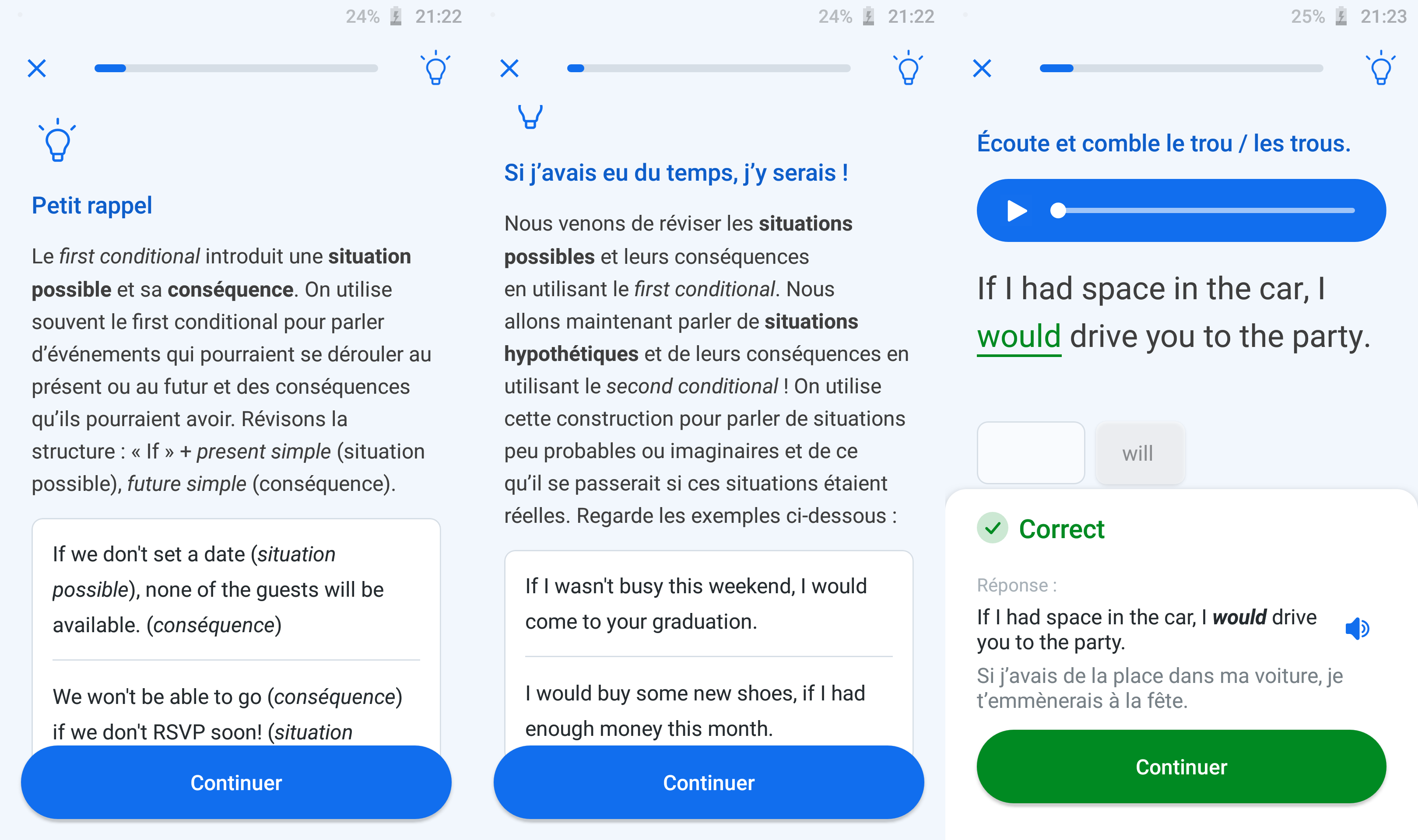
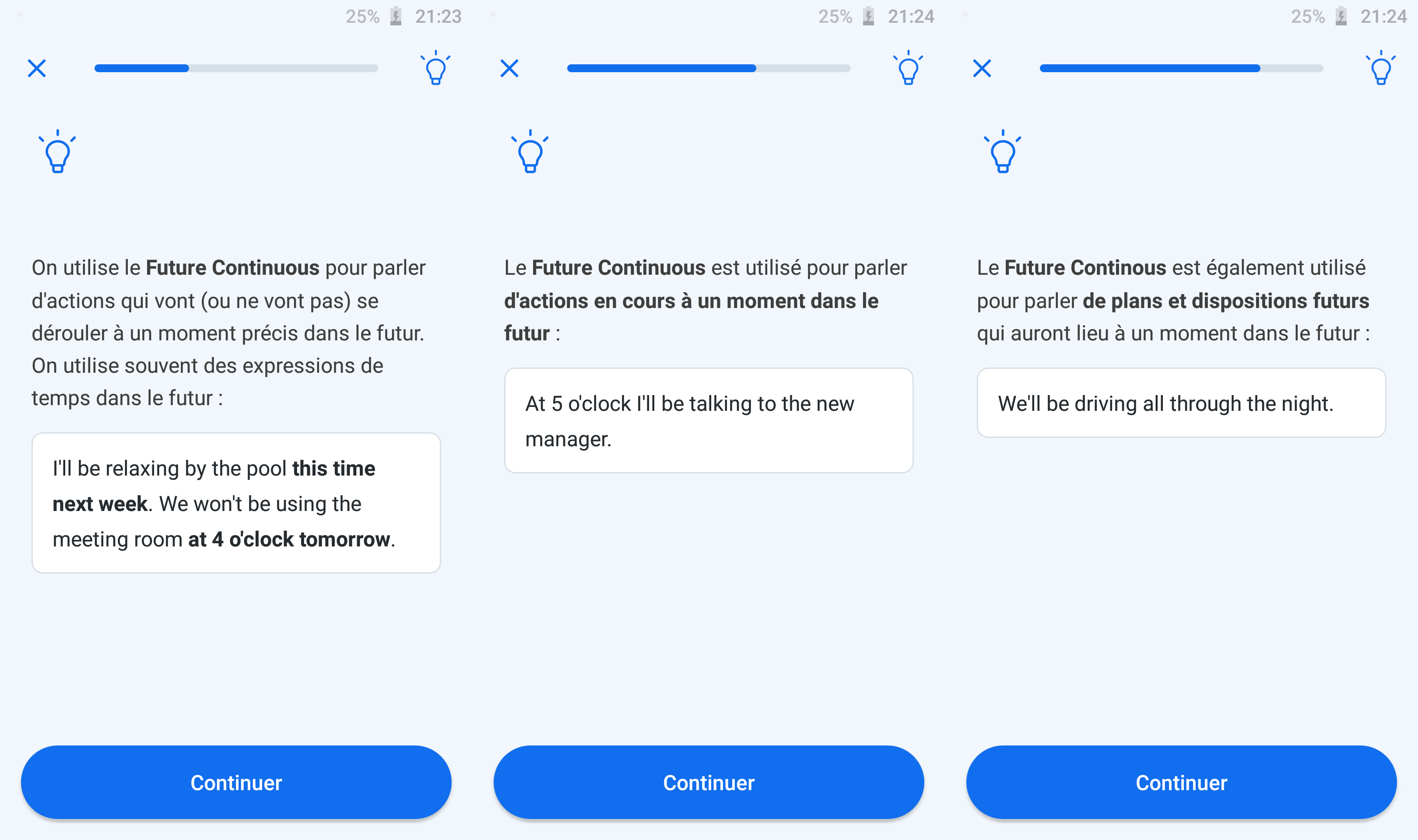
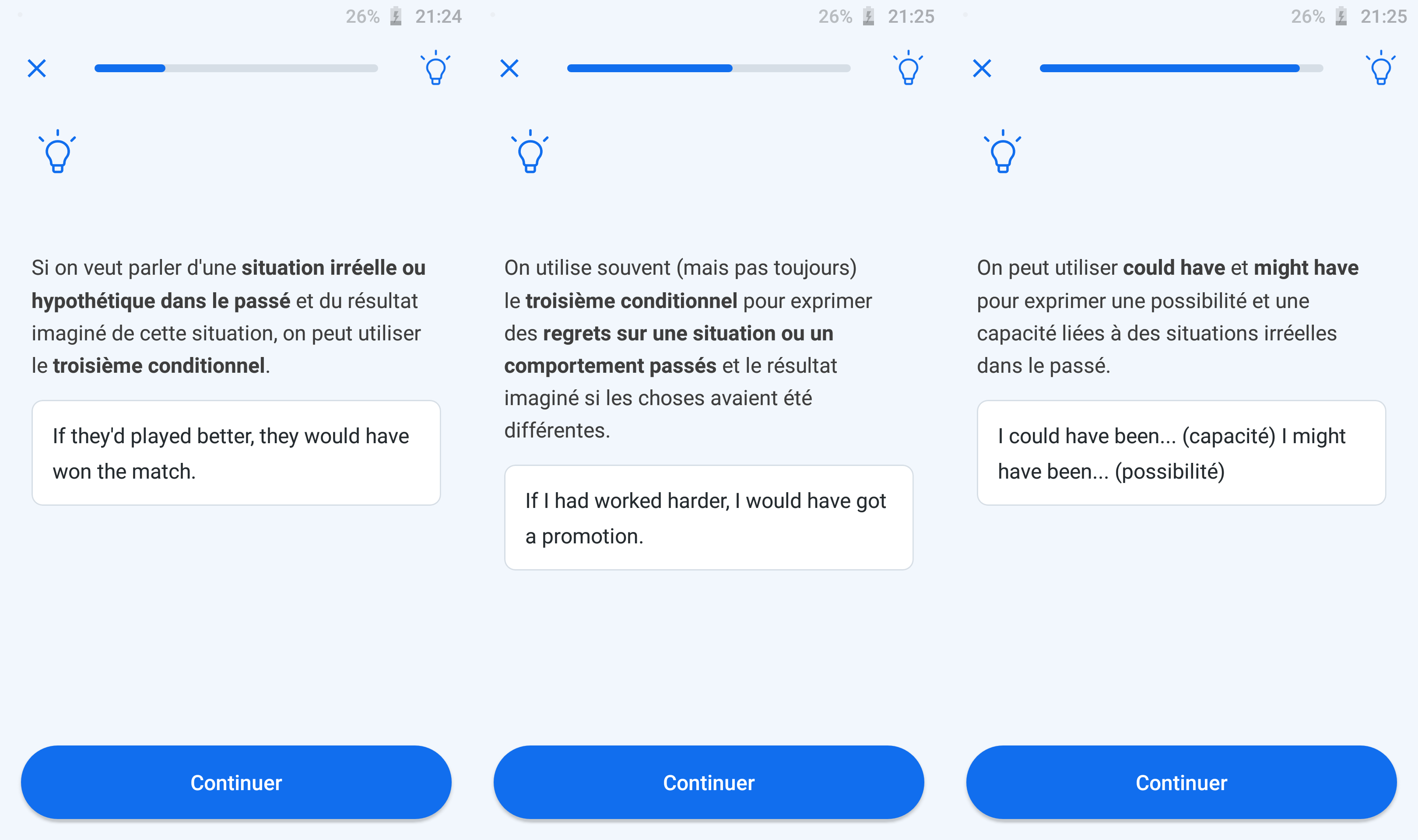
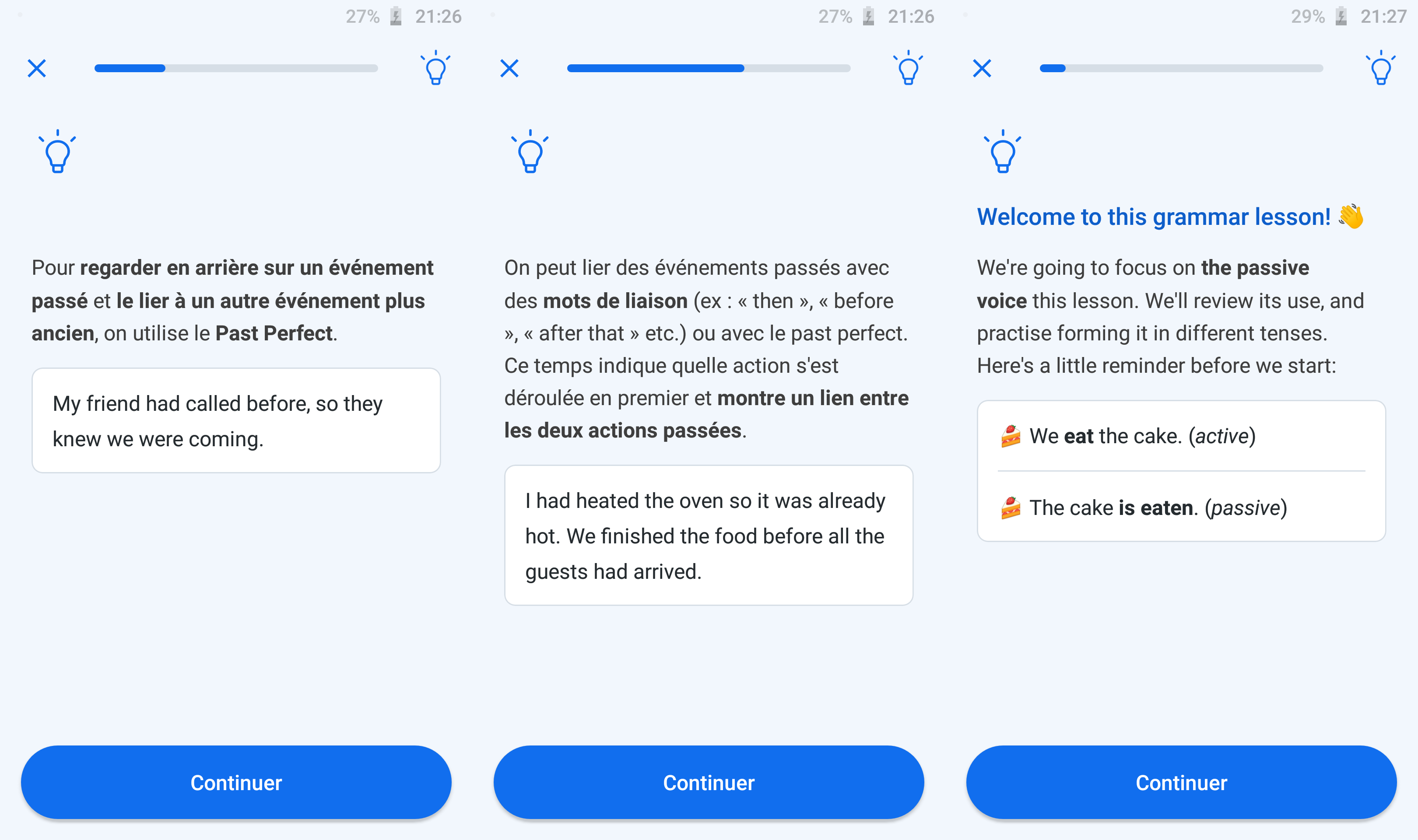
I finally explored learning Russian from either English or French, and I was equally satisfied. We have a winner!
Bottom line: at least for Italian, German, and Russian, it performs; also for learning English from another major language.∎
🟢🟢🟢🟢🟡 iTalki
This app is only a pretext, and you never pay for the app; what you pay for is the real people you’ll interact with, and you’re actually paying them! Professional or ad hoc language teachers, that is. For learners keen to spend some money to interact with real people who will be their tutors, this is the choice (beware of imitations!). I expect it to have become even more popular during the pandemic. Obviously, not all teachers are created equal, so first book a trial lesson when considering a teacher (trial lessons are cheaper and sometimes even free). Based on her YouTube channel, her blog and her Soundcloud podcast, I’d say that Lucrezia should be a great teacher of Italian.
Obviously, the app is not needed, as the website can be used instead. Also, the app is rather heavy and there are many complaints about it, but on the positive side, it’s also in Huawei’s AppGallery.
Bottom line: real teachers in a virtual environment.∎
🟢🟢🟢🟢🟡 Fluenz
Yes, it’s expensive. Yes, it’s strikingly American. And yet, its mostly video-based approach, with nice tutors (at least for Italian, Latin American Spanish, European Spanish, and Portuguese), makes it a winner and unique in its category. The usability could be somewhat improved, but the contents is extremely well thought. It might have a slow pace (which makes it expensive to reach a more advanced level), but the explanations are extremely thorough, and fully in American English. The “full immersion” dogma isn’t something Sonia Gil, the founder of Fluenz, believes in; all explanations are in English, not in the target language, and the course insists on the various difficulties that an American would have while learning the respective language. I agree with some commenters that the French tutor doesn’t have the best possible pronunciation, and I find that the German pronunciations aren’t the most Hochdeutsch ones, but for the languages mentioned at the beginning, it’s a great choice. It can only be used to learn: French Upgraded, German, Italian, Mandarin Upgraded, Portuguese, Spanish (Spain), Spanish Upgraded (Latin America). “Upgraded” means it’s an improved edition of the original formula of the respective course.
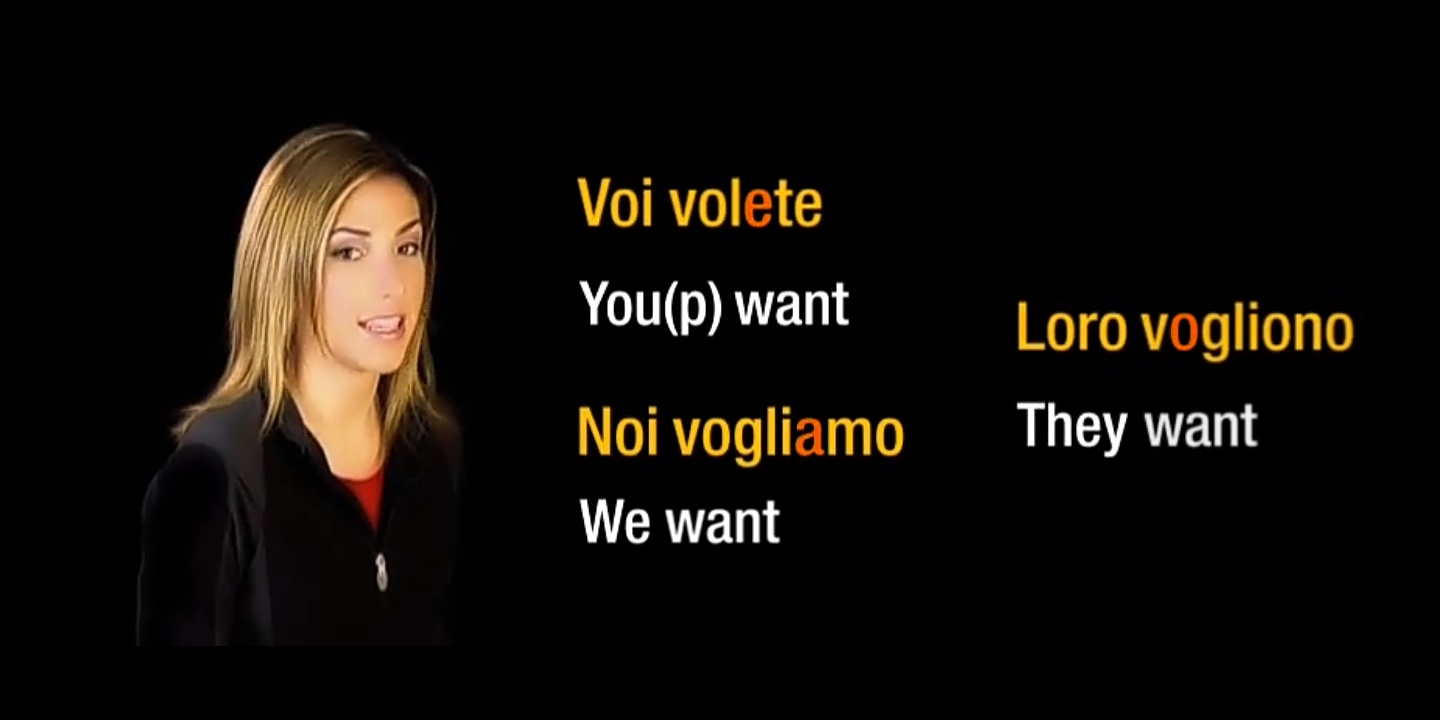
Bottom line: astounding videos, excellent for Spanish (Spain and Latin America), Portuguese, Italian.∎
🟢🟢🟢🟡🟡 Memrise
Nothing never heard of, but it seems to include the right progression rate and the right amount of repetition that allows a good start from zero in any included language. Initially created as a language course without grammar lessons, now it does include grammar lessons in the “main” language courses (i.e. not in the community-made ones). The grammar lessons are available in ten courses: from both UK and US English (despite what’s written there), to French, Spanish (Spain), German, Italian, Japanese, Mandarin, Russian, and Korean; from Spanish (Spain) and Russian to English. The grammar lessons only show up in the modules 1+2 of the 7 modules that make each of these courses.
IMPORTANT LIMITATIONS: one must be schizophrenic to fully benefit of what Memrise has to offer, and here’s why:
- The grammar lessons are only available in the app, not on the website, and only if you pay!
- The community-made courses, which are completely free, can only be accessed on the website, not in the app!
The first limitation is an absurd one. The second one is frustrating, as the “main” courses only have 7 modules, e.g. “German 1” to “German 7,” but on the website there is much more, including contributed material as distinct modules, such as Learn German Grammar, Learn German Conjugation, and a lot more. Also, the Brazilian Portuguese strongly benefits from the community.
The “official” courses feature pronunciations (with videos!) by native people, namely people on the street, not teachers. Community courses usually don’t have videos, and sometimes not even audio. Using the app (grammar!) should be a pleasure for the beginners of all levels of education, especially as the grammar is presented in a very casual way.
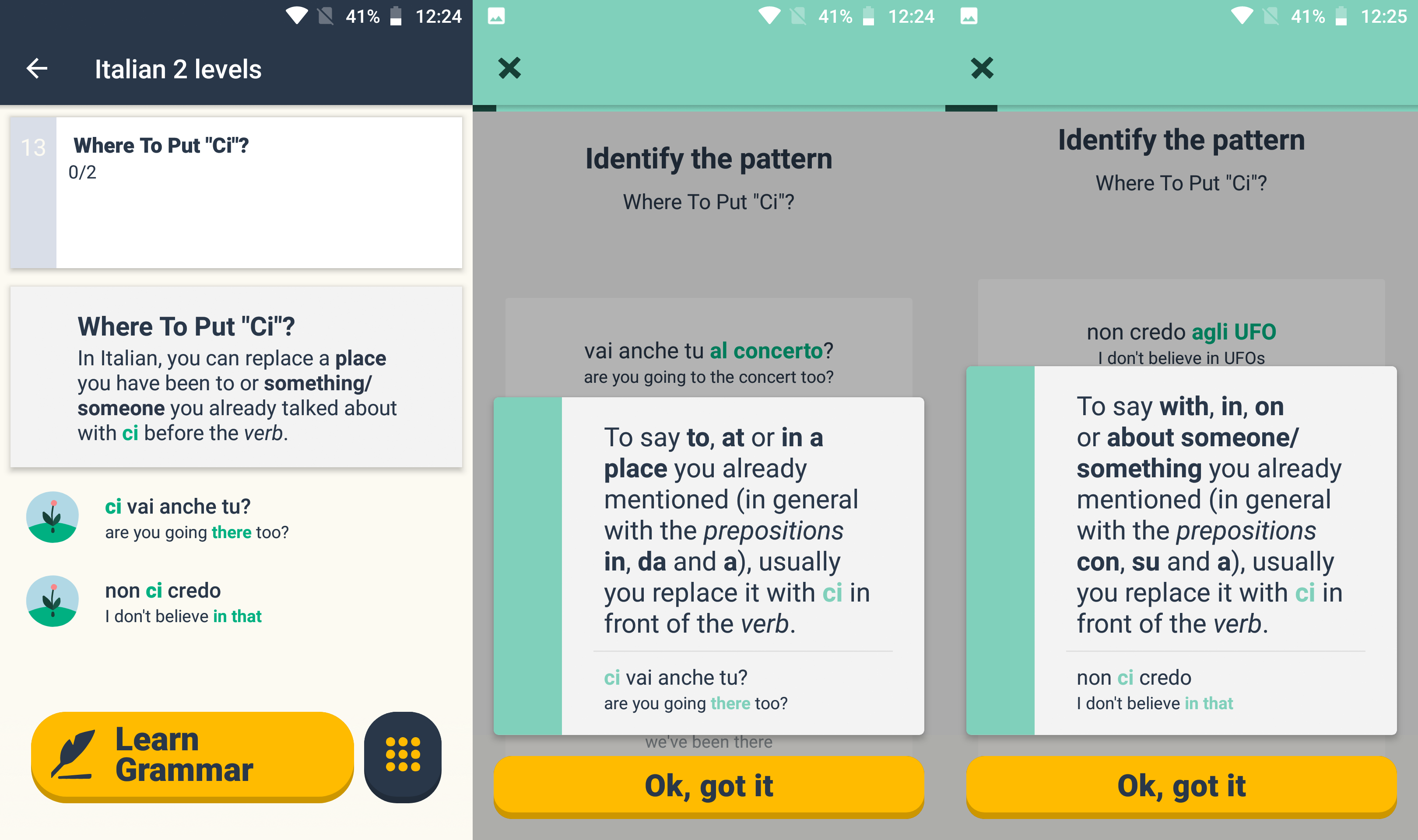
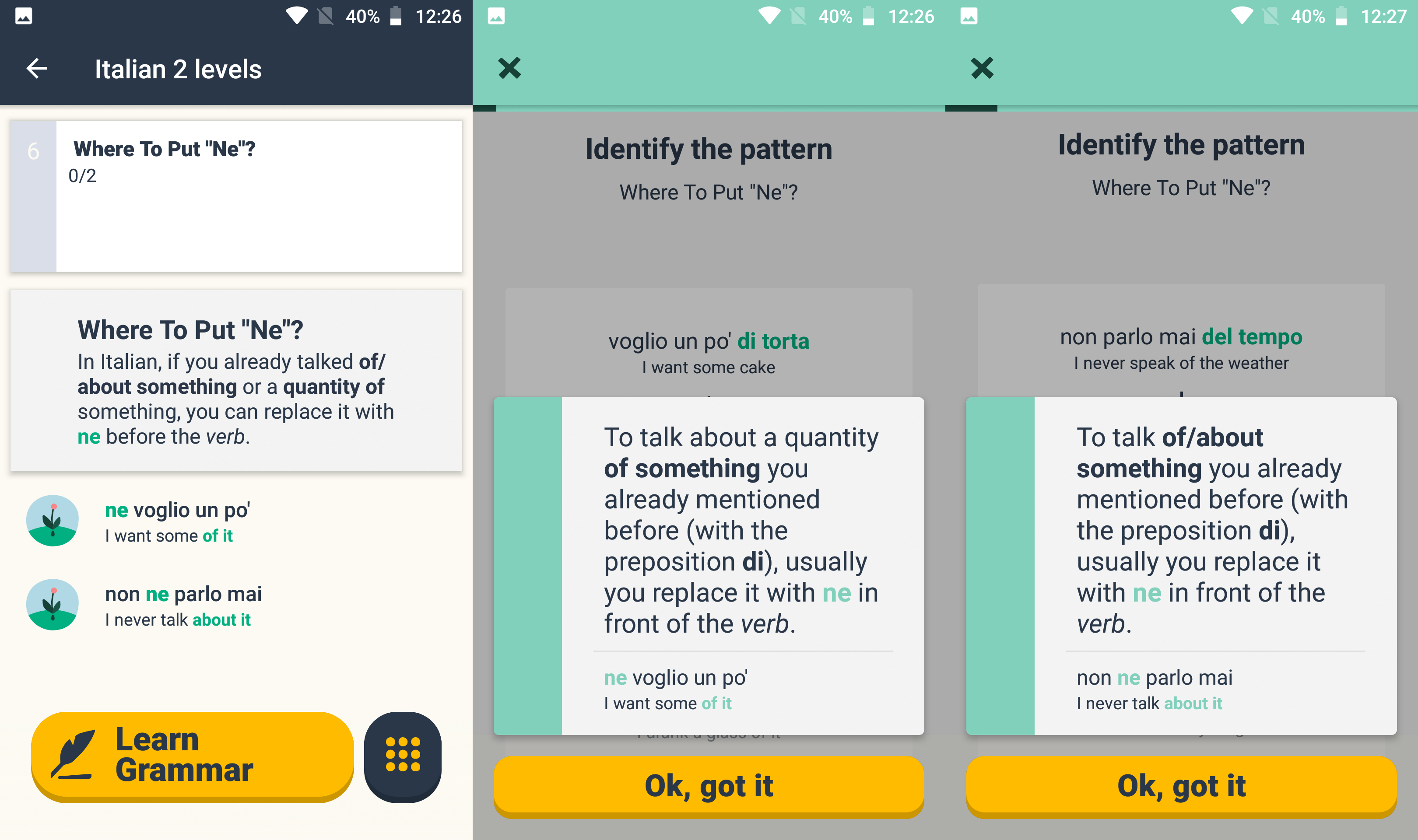
Unlike Duolingo and Babbel, the way questions are asked in French is correctly taught:
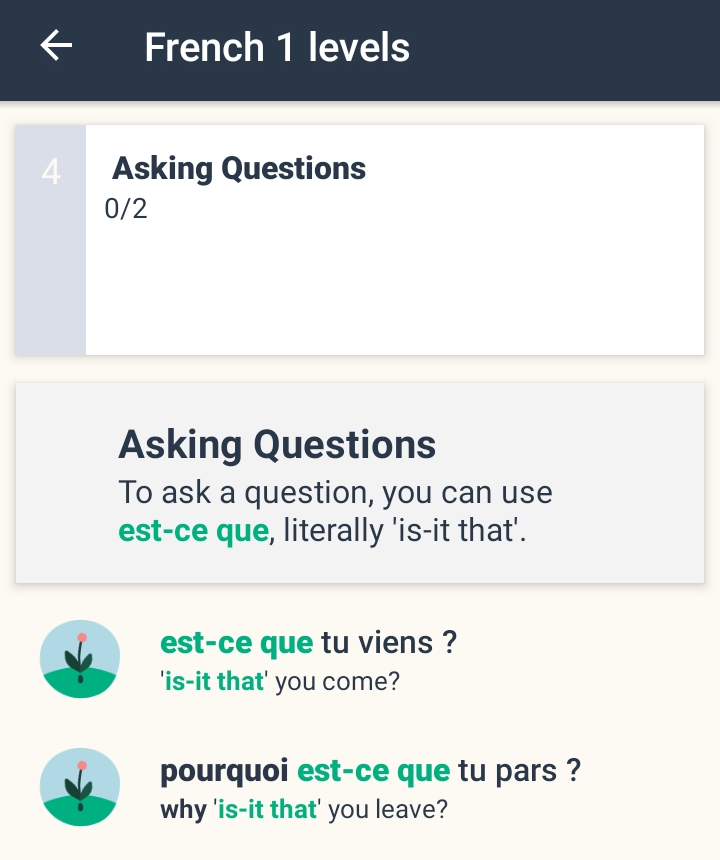
Bottom line: straightforward and easy to use, but as a beginner stick to the courses that contain grammar. Check their blog for some funny language insights.∎
🟢🟢🟢🟡🟡 Assimil apps by Mantano
The apps suck big time, at least for me. Even with the October 2020 update, the usability is still miserable! Having so much information visible right away on facing pages–the right page being the translation of the left one–is one of the strengths of Assimil’s books!
Here’s how a lesson starts: you can see either the first screen, where the sentences are shown without translation of pronunciation helpers, or the second screen (tap on the 2nd tab, or swipe left), where the sentences are shown one at a time, with all the possible info, but in such an unpractical way! To match the experience of the printed book, you’d need to continually go back and forth between the first two screens! With a printed book, you’d see much more at once without the need to “interact” with it. (I refuse to bend to their “recommended way of reading a book and of using an app”; NOBODY can tell me NOT to read the footnotes and NOT to look at the right page before reading the left one, or NOT to move my eyes back and forth between facing pages!)
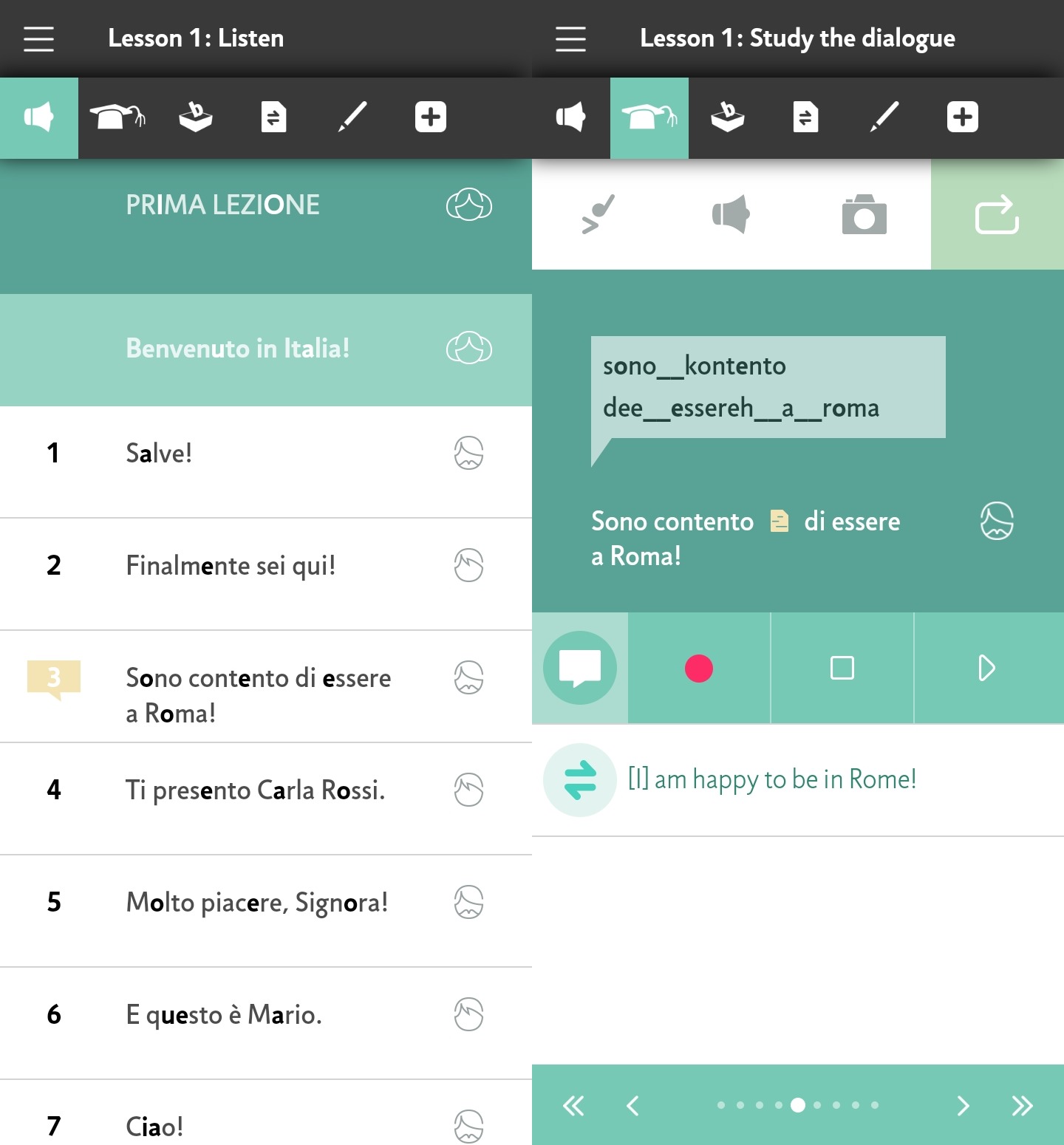
They could have designed a first screen that includes the functionality of the second one by dynamically expanding the current item:
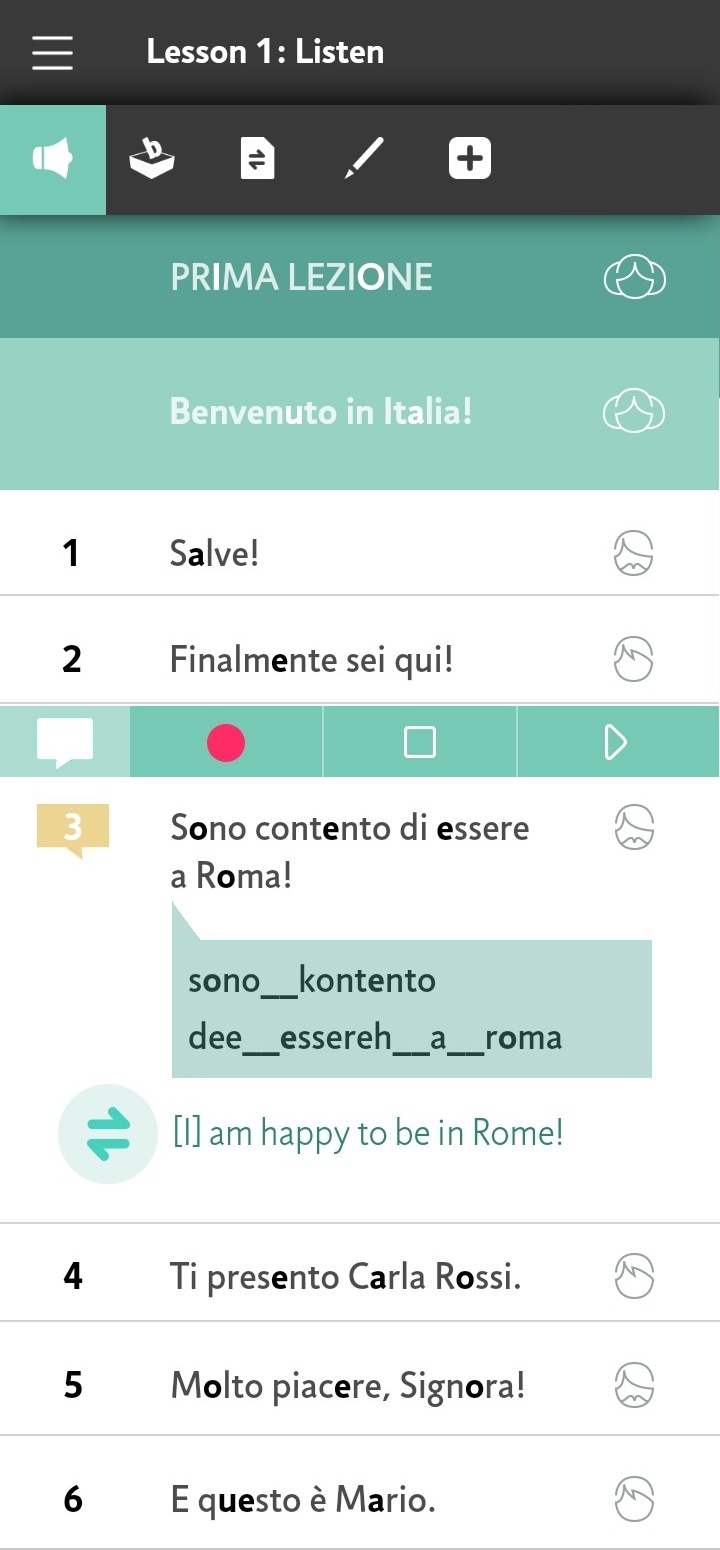
Obviously, they were too stupid for that, and they didn’t. The concept shown in the above mock-up never occurred to them, but I’ve seen so many stupid design decisions that what I do in such situations is to never use the respective app. While using their printed books, there is so much information instantly available to you!

With a book, you can move your eyes sans peine, using the facing pages as a dashboard rich in information.
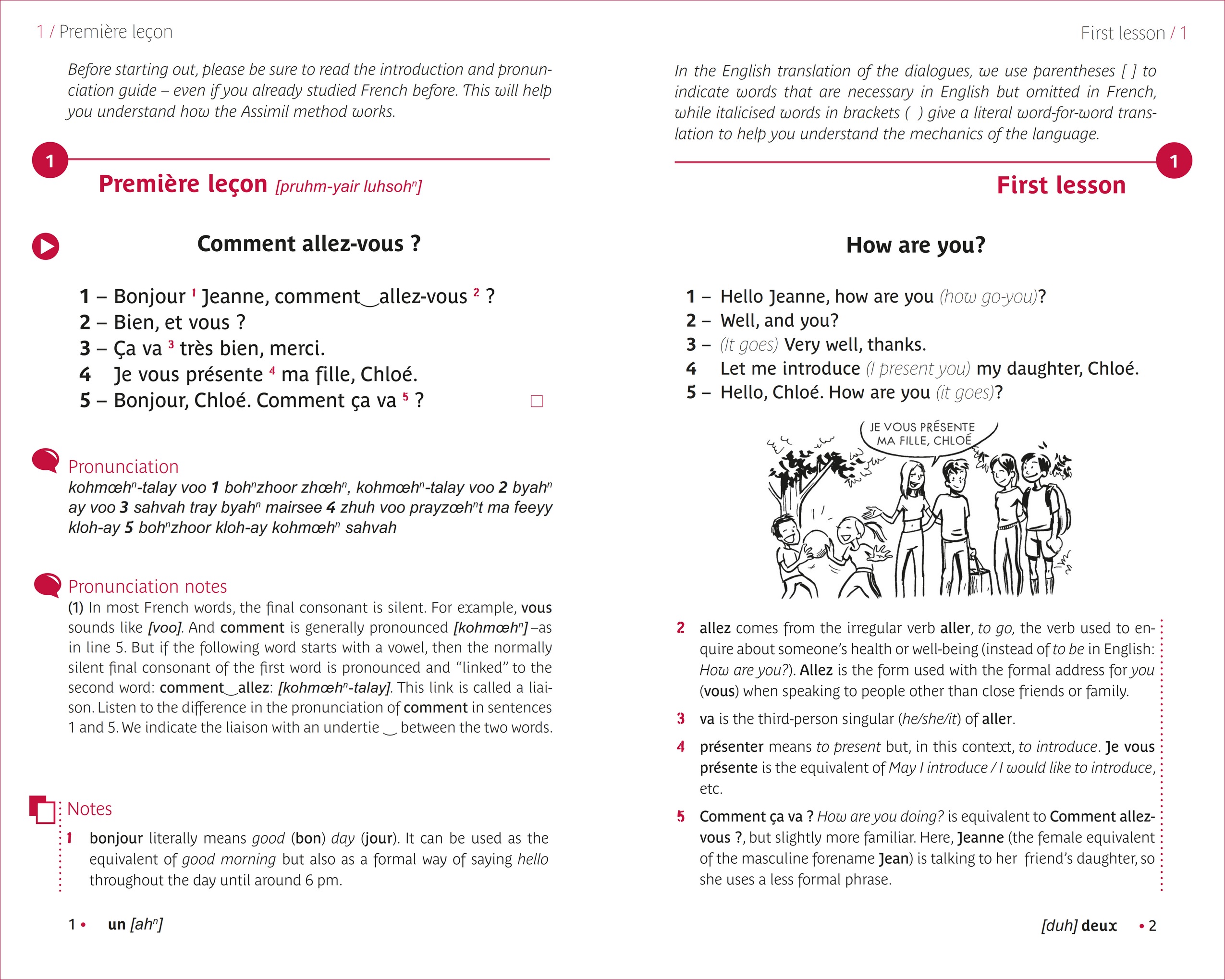
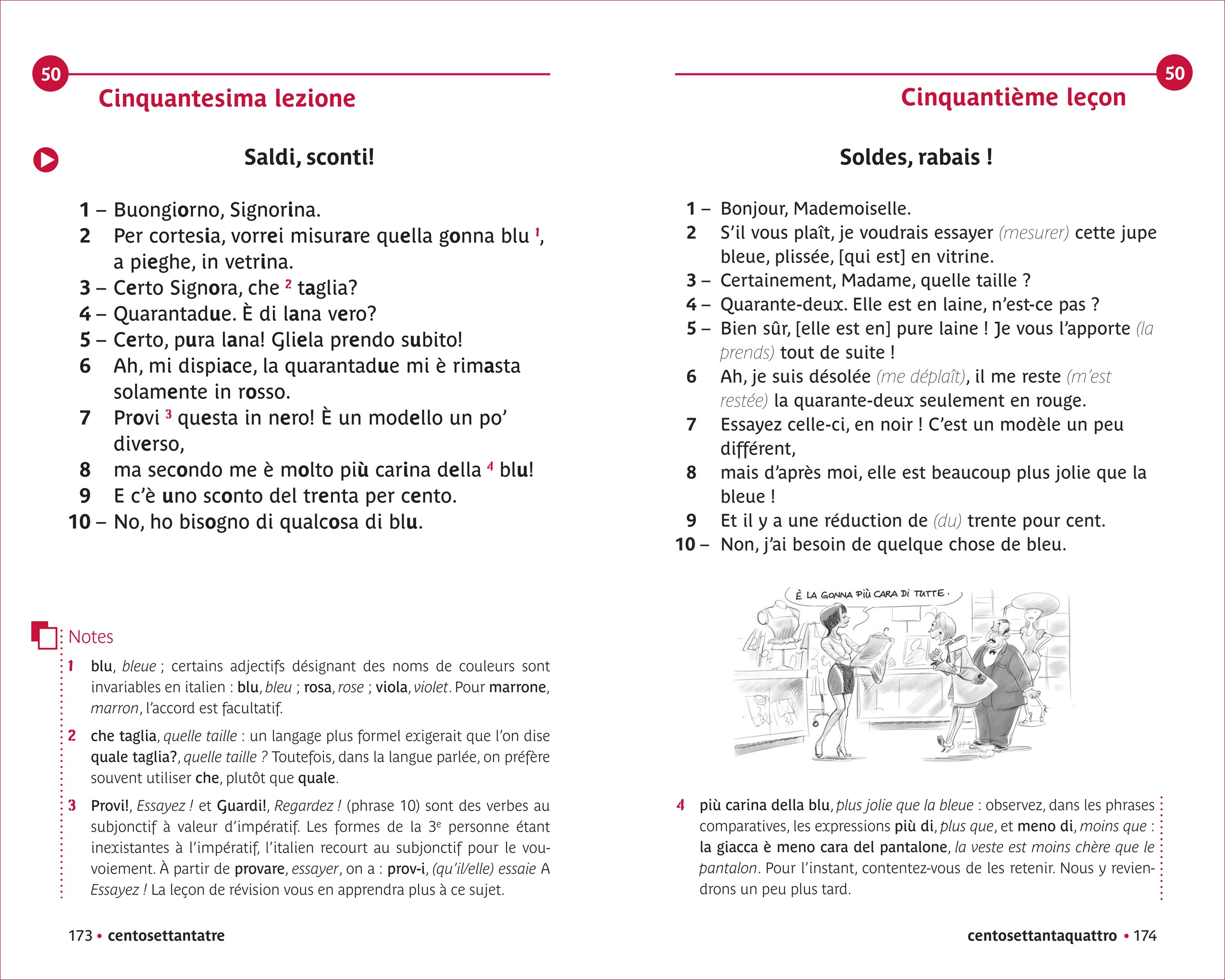
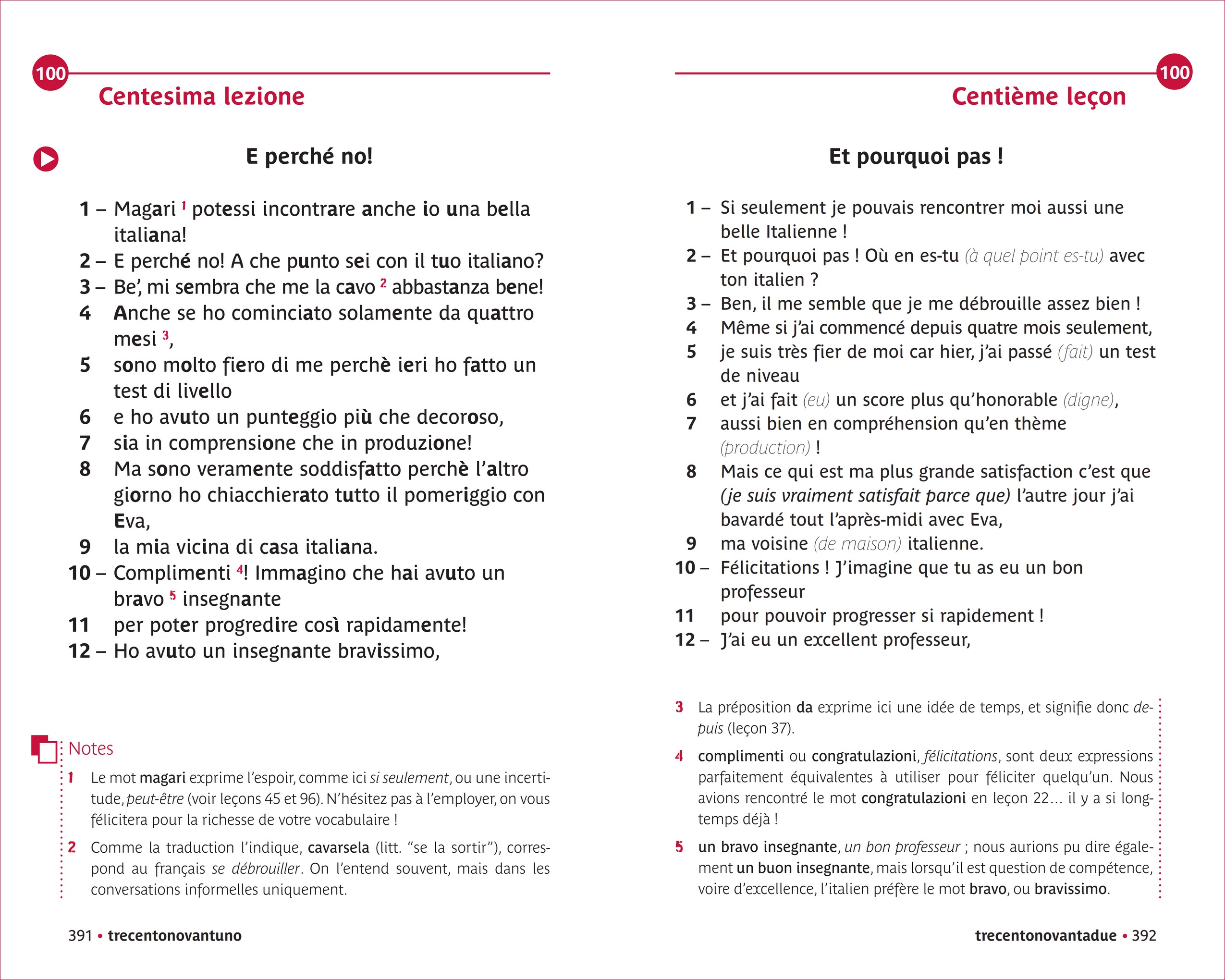
So screw the apps and go for the printed Assimil books with MP3 support (CD and USB stick; unfortunately both of them aka “superpack” for most language pairs; from French to a few major languages there is a choice between: USB pack, audio CD pack, MP3 pack). The most traditional method ever, not only from French to other languages, but also from English or Spanish. Sure thing, I very much preferred the contents their books used to have in the 1960s and the early 1970s, with magnificent illustrations by the fabulous Robert Gring (see this and this); the contents became less and less inspired following the revisions that took place in the 1980s, 1990s and 2000s, but even three reviews later, the method is still excellent, even if “old-style” for some.


Even for the books, I could object to the Procrustean rule of having exactly 100 lessons when possible (the major languages). Before the first major overhauling that took place in the 1980s, the Assimil courses were of variable length: 140 lessons for learning French or Italian (later 105), 126 for German, 112 for Spanish (later 109), 101 for Latin, etc. I must be too old to say this, but the best courses were those written by Alphonse Chérel himself!
Bottom line: there are methods designed for screens (Busuu, Memrise, Duolingo, etc.), and methods designed for printed books; Assimil was designed in 1929, and there’s nothing wrong in that.∎
🟢🟢🟡🟡🟡 Duolingo
The most famous well-rated app I don’t like much; and yet, here’s the most spectacular change of mind of mine: I reassessed Duolingo as “not that crappy after all,” after having revisited it and after having unlocked the full courses for French, German, Spanish, Portuguese, Italian, and Romanian (also from Romanian when coming from English). In the past, I didn’t notice that many of their modules (called “skills” that form a “skill tree” in their parlance) have a “tips” button at the beginning, which typically open pages that show a decent degree of grammatical explanations. It was very different some 6 years ago, when I first tried it. Of course, for many languages the audio still seems to be using TTS, which is just pathetic.
In the last years several revisions have been made, sometimes removing some “skills” only to replace them later, often with many more.
IMPORTANT LIMITATION: from within the app one cannot tell which course is made by Duolingo and which one is crowdsourced (made by the community). The problem is that in the community-made courses the “tips” section is only available on the website! When a course in the app completely lacks grammar (not a single skill has a “tips” button), it’s because it’s a community course. Such courses typically are:
- from English: courses for “niche” languages, such as Romanian, Hungarian, Finnish.
- from other languages: most courses, including learning English.
This being said, not all courses are born equal, not even the non-community ones. As I am writing this, the French course is huge, with 220 “skills” and 9 checkpoints; Spanish has 209 “skills” and 8 checkpoints; Portuguese has 94 “skills” (those from here plus Christmas, Flirting, Idioms) and 11 checkpoints; German has 136 “skills” (those from here, where the 5th part is posted separately, plus Idioms, Flirting, Christmas) and 5 checkpoints; Italian only has 69 “skills” (those mentioned here, plus Flirting, Idioms, Christmas) and 4 checkpoints; the community-made Romanian has 62 “skills” and 5 checkpoints.
English speakers can learn 37 languages (36 actually, as Klingon is made-up); French speakers can learn 6 languages (EN, ES, IT, DE, PT, Esperanto), the Dutch and the Germans can only learn 3 (EN, DE, FR; respectively EN, ES, FR); Italians can learn 4 (EN, FR, DE, ES); Romanians can only learn English.
Here’s how the various grammar aspects are introduced (scattered among the many “skills”) when learning various languages from English:
- for French: Present Tense 1, Present Tense 2, Articles, (Checkpoint 2), Reflexives, To Know (savoir vs. connaître), Commands 1 (impératif), (Checkpoint 3), Past Tense 1, Agreement 1 (accord), Past Tense 2, Past Tense 3, Past Tense 4, (Checkpoint 4), Future Tense, Reflexives 2, (Checkpoint 5), Objects (compléments d’objet), Future 2, Relative Pronouns, (Checkpoint 6), Commands 2, Le gérondif, Agreement 2, (Checkpoint 7), (Checkpoint 8), (Checkpoint 9). — A bit thin. Where is the subjunctive? It might be somewhere hidden in the phrases, but it’s nowhere highlighted! So many “skills” for so little grammar?!
- for German: nothing very specific before (Checkpoint 2), Accusative, Plurals, Grammar 1 (which actually contains no grammar, but vocabulary!), Verbs 1, It’s Mine (possessive), Grammar 2 (negation), Pronouns, Asking (not grammar, but W-Fragewörter), Dative, Dative 2, Dative 3, Imperative, Grammar 3 (no explanations), (Checkpoint 3), Comparison, Qualifiers, Grammar 4 (Adjectives: Predicative 2), Adjective, Verbs 2, The Future, Modals, Adverbs 1, Verbs 3, Grammar 5 (comparisons), Grammar 6 (no explanations), (Checkpoint 4), Verbs 4 (no explanations), Objects (no explanations), Future 2, Grammar 7 (no explanations), Reflexive, Verbs 5 (no explanations), Verbs 6 (no explanations), Conditions, Verbs 7 (no explanations), Passive, Adverbs 2, Verbs 8 (no explanations), Verbs 9 (no explanations), Pronouns 2 (no explanations), (Checkpoint 5). — Ah, Indirekte Rede, Konjunktiv I+II, are they hidden somewhere, or not? German is indeed a very complex language, but this course is a huge mess.
- for Spanish: Present Tense 1, (Checkpoint 1), Agreement, Present Tense 2, To Be (ser vs. estar), Phrases 2 (includes conjugations), (Checkpoint 2), Go for it! (includes conjugations), Stem Changes (in verbs), Requests (imperative), Objects, Past Tense 1, (Checkpoint 3), Past Tense 2, Traditions (imperfect), Past Tense 3, Last Week (preterit), Nostalgia (imperfect), Narrative (even more imperfect), Past Tense 4, Objects 2, (Checkpoint 4), Find Out, Past Tense 5, Future, Requests 2, Requests 3, Future Tense, Fiction (some verbs), Requests 4 (with irregular verbs), (Checkpoint 5), (Checkpoint 6), (Checkpoint 7), (Checkpoint 8). — Grammar elements are present in many other places, but they’re not explained. Rather messy though, and incomplete.
- for Portuguese: Plurals, (Checkpoint 1), Adjectives 1, Possessives, Prepositions 1, Preposition Contractions 1, (Checkpoint 2), Present 1, Prepositions 2, Preposition Contractions 2, (Checkpoint 3), Infinitive 1, Phrasal Future Tense, Place Adverbs, To Be (ser vs. estar), Preposition Contractions 3, Demonstratives, Preposition Contractions 4, (Checkpoint 4), Pretérito Perfeito, Conjunctions, Prepositions 3, Imperative, Comparison, Adjectives 2, Adverbs, (Checkpoint 5), Present 2, Present Continuous, Past Imperfect 1, Clitic Pronouns, Infinitive 2, (Checkpoint 6), Determiners, Participle, Prepositions 4, Pronouns, Present 3, Adjectives 3, Pretérito Perfeito 2, Pretérito Perfeito Composto (yay), Imperative 2, (Checkpoint 7), Pluperfect, Future, Future Subjunctive (you’ve read right, and this makes Portuguese kinkier than Spanish, French, Italian), Infinitive 3, Future Perfect, (Checkpoint 8), Subjunctive Present, Continuous 2, Conditional, Conditional Perfect, Modal Verbs, (Checkpoint 9), Subjunctive Past (huh), Past Imperfect 2, Subjunctive Pluperfect (geez!), (Checkpoint 10), (Checkpoint 11). — A bit strange, but strong and neat grammar! Not bad.
- for Italian: Plurals, Possession, (Checkpoint 1), Questions (with tiny grammar bits), Present 1, Conjunctions, Prepositions, (Checkpoint 2), Adjectives 1, Present 2, Adverbs, Clitic Pronouns 1, Determiners, Present 3, Present Perfect, Adjectives 2, Infinitives 1, Pronouns, Formal You (not grammar, but important), Imperative, (Checkpoint 3), Past Perfect, Adjectives 3, Adverbs 2, Infinitives 2, Future, Gerund, Future Perfect (wow!), Subjunctive Present (yay!), Verbs: Conditional, Verbs: Modal, Conditional Perfect, Subjunctive Perfect (mamma mia!), Subjunctive Imperfect (I’m dead), Past (passato remoto = preterit), (Checkpoint 4). — It ends a bit abruptly, but so far it’s only the second language for which Duolingo provides a decent grammar, with advanced topics!
- for Romanian (community course, with no “tips” in the app): Plurals, Adjectives, Definite Articles Singular, Definite Articles Plural, Infinitive, (Checkpoint 1), Possessive, Adjectives of Comparison, Present 1, Present 2, Accord of Pronouns, (Checkpoint 2), Prepositions 1, DPPA (Demonstrative Pronouns and Pronominal Adjectives), Dative Pronouns, Genitive-Dative Nouns, Conjunctions, Adverbs, Pronouns, Prepositions 2, (Checkpoint 3), Reflexive, Past 1, Past 2, Imperfect, Subjunctive (conjunctiv), Future, Gerund, (Checkpoint 4), Optative-Conditional (too bad there are no tips, it can be tricky), IVVS (Impersonal Verbs and Verbal Structure), (Checkpoint 5). — Only usable on the website!
Let’s add some more criticism:
- for French: they only teach (so they actually don’t teach anything!) asking questions without any inversion verb-subject, and without “est-ce que“! E.g. Tu as un passeport ? Il se souvient de moi ? Preposterous. Low-level French. The 3 ways of asking questions in French are properly covered in the first half of this video: Comment poser une question en français – How to ask questions in French. How can one expect to learn proper French grammar from such an inept course?! How about “L’accord du participe passé employé avec l’auxiliaire avoir”?
- for German: learning German is a long journey, and I suspect Duolingo would rather frustrate you. I’m not sure you’d pass an A2 test after having used Duolingo. But then, learning German as an adult is always frustrating, and I can’t really recommend any method to this purpose. Is Duolingo better than Babbel for German? Hard to tell.
- for Spanish: if you’re coming from a Romance language, it should be fine for you, but if you really come from English… I dunno. It’s practical though to be able to ask, as taught by Duolingo in Flirting: ¿En tu casa o en la mía? Oh, and their pronunciation of Spanish is strangely “neutral” in the sense that it’s neither as in Spain nor as in Mexico. Officially “based on Latin American Spanish, but as inclusive as possible.” Not that bad.
- for Portuguese: one of the two languages for which I’d recommend Duolingo. What’s taught is a “neutral” Portuguese.
- for Italian: the other language for which I could recommend Duolingo! (But again, I speak Romance languages, so I can figure it out easier.)
- for Romanian: specific to Romanian is the fact that the pronouns used as subjects are optional, just like in Italian; but Duolingo ignores that and insists on using pronouns, so the Romanian phrases shown by Duolingo are a bit weird. I checked the Religion “skill” only to find stupid sentences such as: We believe in many gods. I saw the spirit above the church. For us, faith is something big. God is holy. I have faith that God listens to my prayers. Soccer is like a religion in Germany. Unnatural sentences include: Would you disappear with me? He would learn to play trumpet. They go to take the oranges. We do not know our grandmother.
- for learning English from Romanian: even worse. E.g., insisting on translating back and forth such things in Romanian is crazy: She will have taken our game/our food/the bus. We will have called the police/the doctor/the guardian. I will have found the keys/the restaurant. You will have created a document. We will have chosen this desk. She will have decided to sleep. More unnatural sentences: We sign her shirt. They change you. He says what?
General criticism about the UI: while pleasant per se, it’s highly unpractical as long as one has to scroll down, and scroll down, and scroll down. They couldn’t have thought of a better way of accessing a specific skill in the tree, could they? Then, the labels (the titles) are often abridged, because of the stupid idea of using round icons with labels and nothing more. Finally, the downloaded courses cannot be deleted (except by deleting all the app’s data).
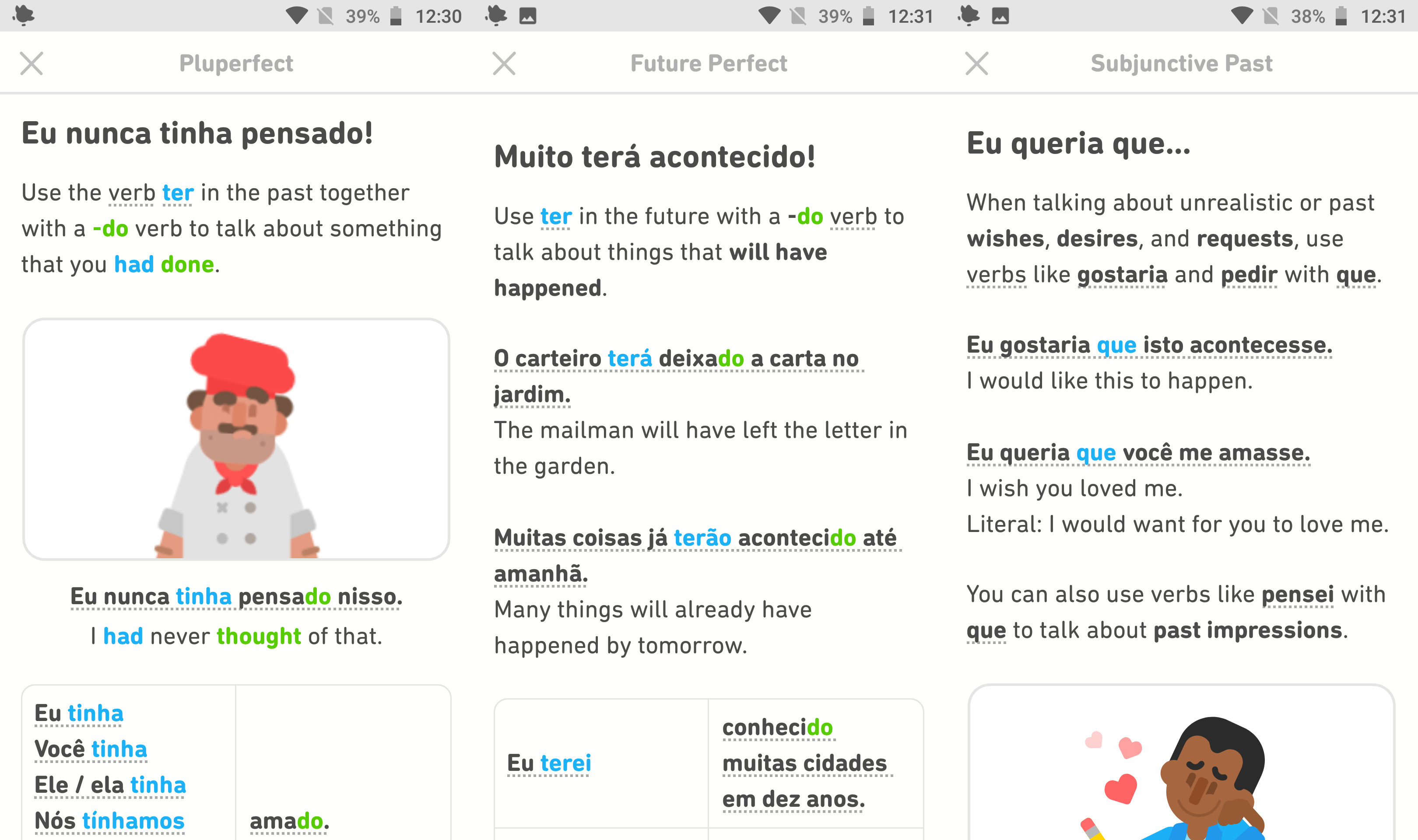

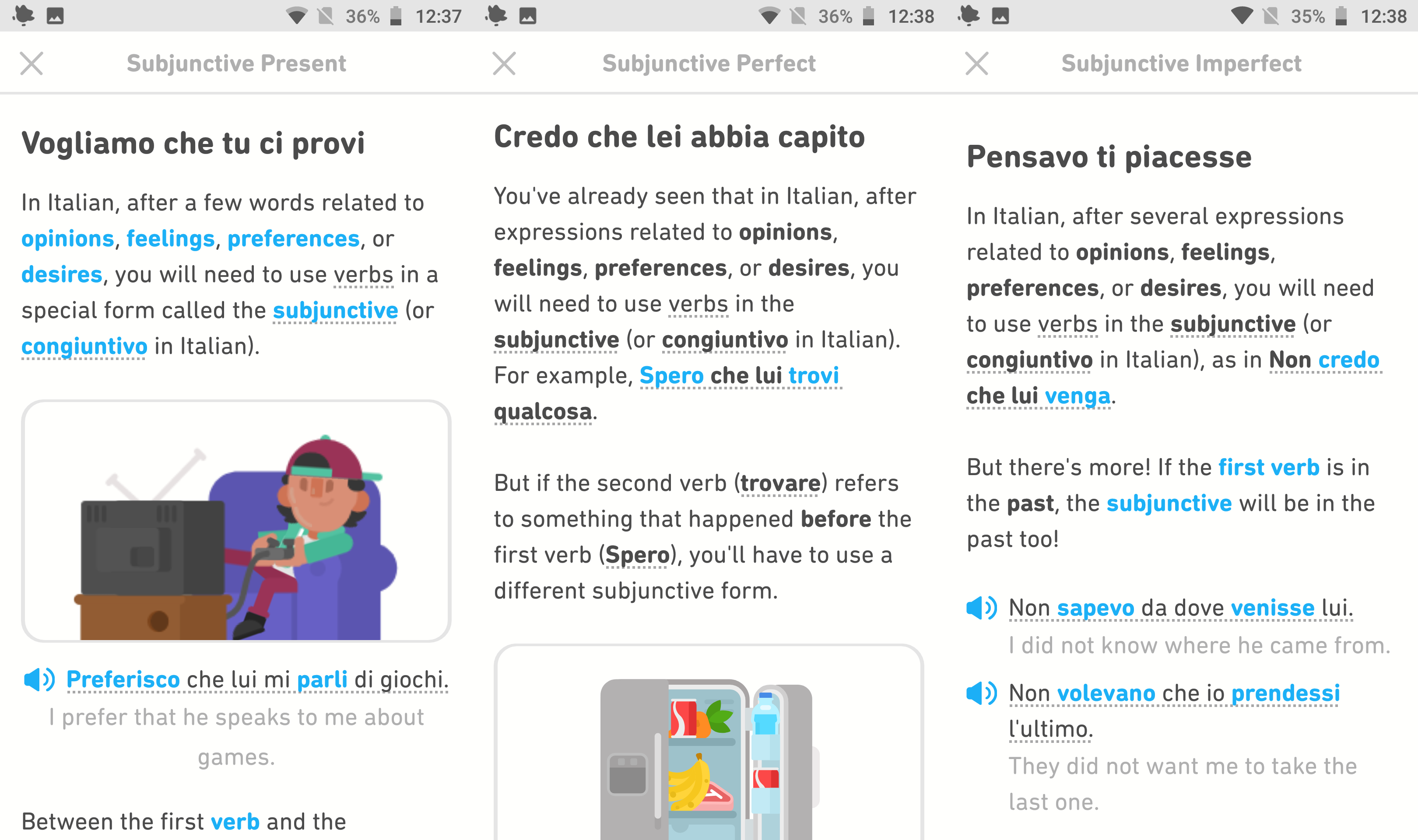
Sometimes, community courses are a complete laughingstock. Learning Finnish starts by assuming you only have the IQ of a dead rat:
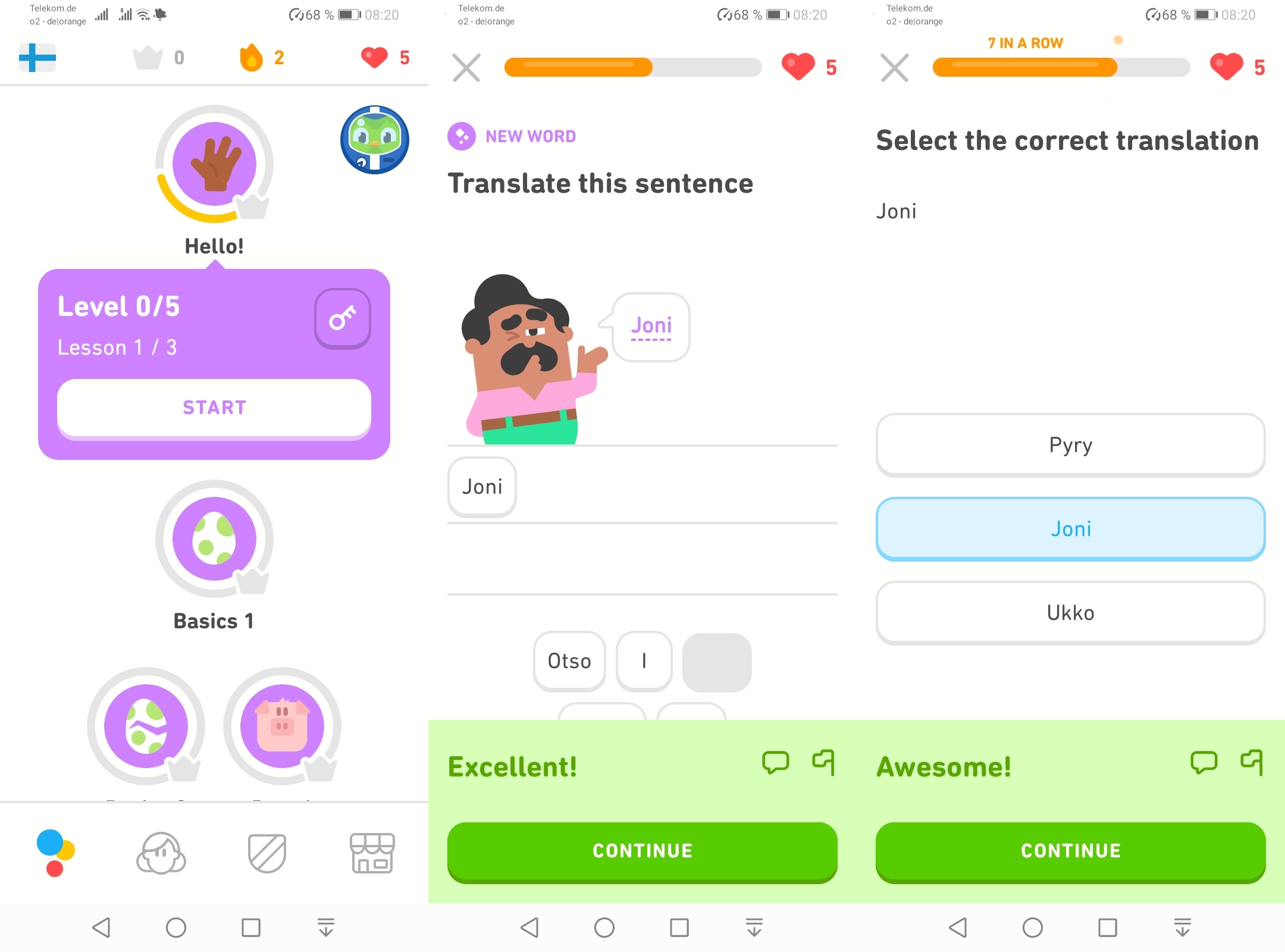
Bottom line: the crowdsourced courses are pathetic, and even from the “house-made” ones I only recommend Portuguese and Italian for English speakers. Still, their online forums can be of some help, regardless of the language pair.∎
🟢🟢🟡🟡🟡 WordBit
Not a course, but strictly a vocabulary enhancer. Not a dumb flashcard app, but one with flashcards that, unlike in other apps, include more than one meaning, and usually several sentences given as examples (or for context, if you prefer to see it this way). The idea is that of a lockscreen-based flashcards (the same as in the app) that force the user to see them. Make sure you select several categories, and that you set the order to random, not alphabetic. Unfortunately for some, it’s Android-only and one has to download a different app for each language pair, but even if you’re Russian, Polish or Romanian and you want to learn English, French, German, Spanish or Italian, you can do it. “Exotic” language pair exist too (Korean-Japanese, Hebrew-Spanish, Arabic-Italian, etc.), but many European languages are not covered.
One flaw though: sometimes, the examples are translated into words that are not in the list of meanings shown for the respective headword! While in a printed dictionary idioms and specific usages can be given to show possible secondary meanings, in the case of a flashcard app the examples are supposed to show some context for the listed translations, otherwise the learner might get confused. I highlighted in pink some otherwise correct translations, but not listed in the upper part of the screen:
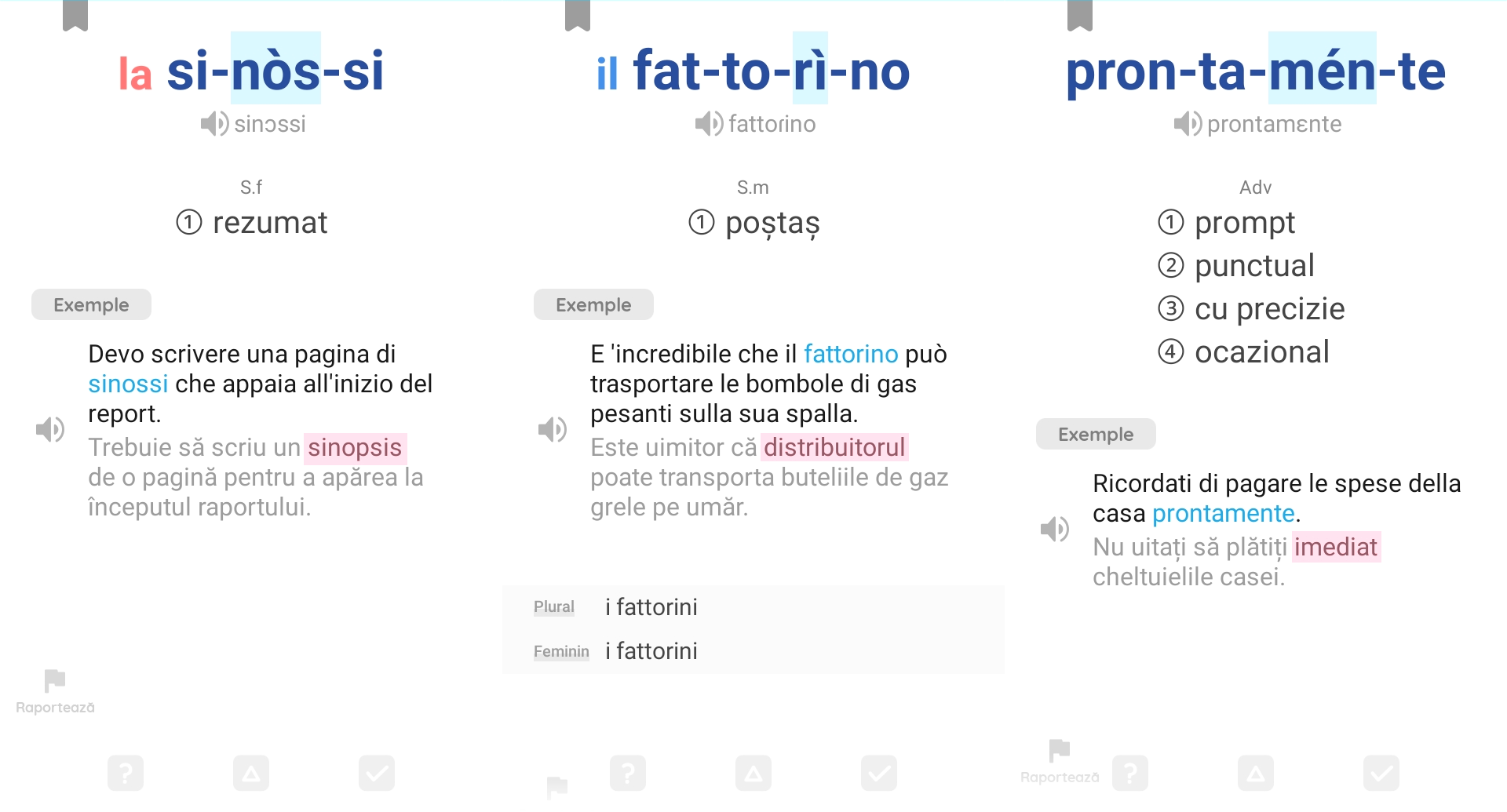
Bottom line: useful to force you learn words in context.∎
🟢🟢🟡🟡🟡 HelloTalk
A much better-looking HiNative, i.e. a social network in which you could get your questions answered by native speakers. Just ignore the audio lessons and stick to the idea of discussing with people. Beware, some might get quite flirty. Population 20M in 2020.
Bottom line: if you don’t like HiNative.∎
🟢🟡🟡🟡🟡 Mango Languages
At first, I thought I’d like it, but now I’m much more reserved. It seems suited for beginners (yet one could also learn Shakespearean English!), and the UI is attractive enough. Some of its good points aren’t that well-thought though, e.g. while one can choose (when appropriate) between a literal translation and an equivalent (“normal”) one, I’d have liked to have them both simultaneously. The grammar is well-explained in English, but everything is too boring and slow to my taste. Voice: «What do you think is the right way to say “Excuse me, where is the square?” to an individual in a formal situation?» (10 seconds of pause follow; the pause can be skipped, the initial voice cannot!)–c’mon, I’ll grow a 3-ft beard before learning a language using this app! Furthermore, their Space Repetition System algorithm is non-adaptive, and it will definitely kill your patience, unlike in Memrise or Lingvist, where if you stop making mistakes, the repetitions will decrease in frequency and number. Also, some cultural or lexical aspects are classified as Grammar Notes, which is absurd. Atrociously American in spirit, but in a much less attractive way than Fluenz, it might piss off some non-Americans.
Still, the choice of languages is consistent (it even has Finnish, Icelandic, Hungarian, but also 4 flavors of Arabic). Trying to cover too many languages isn’t without drawbacks: the Russian module doesn’t make any attempt of teaching you the Cyrillic alphabet; the same could be said about the Armenian alphabet; also, how do you think you’ll learn Arabic? Mandarin, Korean and Japanese are only minimally adapted–I’m pretty sure I couldn’t learn any such language with this app. As for the section on the French argot, here’s Argot, Chapter 1, Lesson 1, Conversation: “On fait la teuf ce soir ?” “Clair !” “Ça va être trop de la balle ce concert !” “Mais ouais, il est chanmé ce mec en live. Je le kiffe.” “T’y vas en caisse ?” “Non mais t’es ouf ? Je vais pas picoler et prendre la bagnole après.” “On prend le tacos alors ?” “T’es sérieuse ? Tu crois que je suis blindé ou quoi ? Tromé, obligé !”). Too bad for the multicolored text, it’s not for me.
Bottom line: you’ll need a lot of patience.∎
🟢🟡🟡🟡🟡 HiNative
When I first tried it years ago, it was the only app in which you could get your questions answered by native speakers. Sure thing, there’s a question to ask: why aren’t people asking questions on StackExchange or on specialized forums (no, not Reddit!) instead of chatting in such an app? Well, they want something like Facebook… so usually they turn to this kind of app. Meanwhile, the competitors are more popular (see below HelloTalk and Tandem) and they offer a more sophisticated UI, yet I still believe HiNative has a more “traditional” community. However, beware that HiNative doesn’t allow you to chat and really communicate with people, but only to have your questions answered (choose HelloTalk if you’re “really social”). Population 5.4M in 2020.
Bottom line: social, but not that much, and not glitzy.∎
🟢🟡🟡🟡🟡 Gymglish
From ten languages, learn or improve your English (Gymglish), English for beginners (Rich Morning), French (Frantastique), Spanish (Hotel Borbollón), German (Wunderbla); or French for native speakers (Frantastique Ortho). All courses are strictly for adults, and extremely professional. I tried for a week Gymglish and Frantastique Ortho, and I can tell they’re ruthless Grammar Nazis! The apps for Android and iOS are one per target language, and also a single one that encompasses all the languages (the one with a red icon). The problem with the business model is that they’re expensive, and one cannot save money by trying a faster pace, as the method imposes one lesson a day, 5 days a week. Either way, never purchase from within the iOS app, as you’ll get the maximum possible price, being billed monthly at €39.99 or more! On the website, which as I’m writing this has a 30% discount, Gymglish Basic can be booked for as low as €10 per month (paid for 3 years in advance), or at most €20 per month (paid for 6 months). To quote them (and I can confirm this is true): “Each day you’ll receive a lesson adapted to your needs, capabilities and goals. Once it’s completed, you’ll immediately receive personalized corrections and explanations. Your English lessons are customized based on your strengths and weaknesses.” Then, “Each of our English/French/German/Spanish lessons ends with a “dessert”: an authentic clip of can’t-miss anglophone/francophone/German-speaking/Spanish-speaking culture. Film, music, literature or television allow you to finish your workout in style.” Anyone can try any of their language courses for free, but what will you do after a week? On the one hand, you’ll probably get hooked (unless their extreme rigor when in comes to grammar will piss you off); on the other hand, it’s not exactly cheap, and it would take quite a lot of time to complete a course.
Bottom line: Berlitz costs three times more. Your choice.∎
🟢🟡🟡🟡🟡 Speakly
Potentially better than Lingvist, with great methods, excellent (but incomplete) grammar notes and the ambition of making you fluent by only using a vocabulary of 4,000 words, this app has the unexpected idiosyncrasy of requiring you to answer all the questions viva voce, even if in Study settings, Learn vocabulary is set to “With multiple-choice answers”! Answering by typing is only available in the Premium version, even for the free content! And it’s even worse: a tooltip on the mike icon reads “Know the answer? Hold button and speak (Premium only),” because “Recording is a Premium Feature,” so basically there is no way to answer in the free version! WTF. (Funny thing, the initial placement test was a multiple-choice one.) Too bad, as the app also includes listening exercises and even songs in the target language. (Does anyone trust the speech recognition software to be accurate enough? I don’t, except for Dragon NaturallySpeaking, to which I can dictate in French and get surprisingly accurate results.)
Bottom line: not if you cannot speak when you learn.∎
🟡🟡🟡🟡🟡 Lingvist
I wanted to like it when it was still fully free (lots of screenshots from back then), and for a while I did like it, despite its limitations and its sometimes questionable translations. Nowadays, it’s become too expensive for what it is. Even “Advanced English” isn’t really advanced, insisting on “teaching” you basic words! Still, it’s extremely professionally designed, and somehow it manages to include an almost decent amount of grammar, so it might appeal to those willing to pay as much as for both Netflix and Amazon Prime.
Bottom line: expensive for what it delivers.∎
🟡🟡🟡🟡🟡 reword
It does help you to improve your vocabulary via flashcards, and it’s one of the few apps to offer Finnish, but I just don’t like it. WordBit is a much nicer product.
Bottom line: mediocre.∎
🟡🟡🟡🟡🟡 BeeLinguapp
A promising helper app, but it never tried to fix its flaws. The concept of having a text translated in the other half of the screen and read by real voices (not TTS) is great, but the contents is abysmal, even in Premium mode: most books are pathetic, “classics” usually means English books in translation, not books written in the target language and translated in English, French, etc., and the overall choice is very limited. The recent addition of news reports helps a bit, but not much. For bilingual easy reading, look for real books (or e-books). Another complaint of mine: the reading speed can be decreased, but not increased.
Bottom line: great idea, pathetic contents.∎
🟡🟡🟡🟡🟡 LingoDeer
Initially designed for Asian languages (on Google Play it’s listed as “Learn Korean, Japanese or Spanish with LingoDeer”), now it covers about a dozen. Maybe the only app (except for the thorough video explanations of Fluenz) that includes proper grammar pages and tables! Still, despite their claim to bring you to B1, they don’t get you beyond A2. My objections? The structure is pretty good, yet the choice of words taught in the first lessons seems random. And there isn’t much of a method other than “vocabulary + grammar” (its grammar notes are labeled “Learning Tips”).
Bottom line: childish, but it might work for Asian languages.∎
🟡🟡🟡🟡🔴 Babbel
It’s a German method, and the Germans are the worst language teachers on Planet Earth, but I was told their best course is (unsurprisingly) learning German through English. I tried it, and I found the structure close enough to what the DaF (Deutsch als Fremdsprache) manuals use, but somehow duller and rather boring. The grammar explanations are correct, but they can be frustrating. There is a good deal of repetition to help you get the idea, but I’m not satisfied with their cursory grammar explanations. Typically German, they knew they had to explain some rules, but their lack of empathy made the whole thing über-mediocre. And this is their best language pair!
I then tried learning French (from English). C’est la cata. At first, it looked like there is some grammar that could be almost enough, even if I couldn’t be sure enough advanced topics are introduced, but then I noticed this thing in Beginner I, Course 2, Lesson 1, Part 1, learn how to ask for the time:
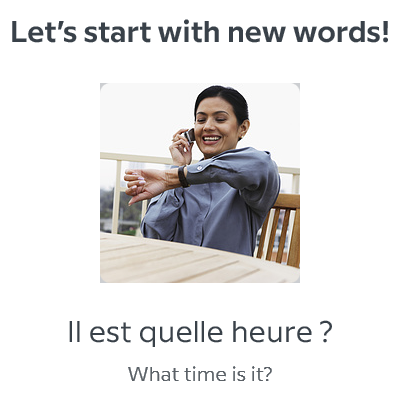
The correct way to ask such a question in French is: Quelle heure est-il ? So they can’t even teach you one of the most basic grammar rules of French! (What they wrote is acceptable in colloquial French, but this is no excuse for not teaching proper French.)
So one cannot trust Babbel. OK, some people might want to try their German course, and who can stop them? Oh, and their sales department is full of jerks: their prices in English include the option to pay just one month (€13), but the corresponding page in French forces you to pay for at least 3 months (€30). Pas glop!
Bottom line: better try Busuu.∎
🟡🟡🟡🔴🔴 MosaLingua
A complex app well-packed with contents, and yet I didn’t manage to like it. There was definitely no chemistry at all between me and MosaLingua, and I tried three of their apps (German, Spanish, Italian) several times at spaced intervals! Returning cards all the time drove me mad! One should need an eternity to reach the desired level. As for the grammar, I found it severely lacking, but one could find some useful content in free access on their website under the tag grammar (with videos, more of which are under the tag video); their YouTube channel can also be of some help, such as the 8 videos on Italian. But then, there are countless YT channels much more helpful (here’s another idea on how to get free language courses in video form!).
Bottom line: you need an insane amount of patience.∎
🟡🟡🟡🔴🔴 Rocket Languages
While the course is a mix of traditional (including grammar and cultural notes) and modern (it’s interactive, meaning you’re supposed to answer back and your voice will be recognized), and the contents for each language is properly adapted to that language, not just a translation of the same English text, I’d never pay their prices: there are 7 modules for each language, but the price is only given for Module 1 ($99.95), Modules 1+2 ($249.90), or Modules 1+2+3 ($259.90), and it’s too high for what a module is. I’ve checked for German, Italian, Spanish and French, and even with all seven modules, you wouldn’t be very much beyond A2.1 in terms of grammar. This might not be essential for basic conversations, but not at such fees. Then, in almost each language, one of the two hosts would have a bad accent: for Italian, the guy is Italian-American, and even I could have a much better take at pronouncing Italian words and names. For French, the guy is British, and its French pronunciation is heavily affected by a British English accent. For Spanish, it’s the gal the one to feature an American English accent; besides, it’s about Latin American Spanish, not “the real” Spanish, so… Oh, for German the accent isn’t a problem. Back to grammar, even if we accept it not going too far, I’m not satisfied with the way they categorize and explain the concepts; nothing wrong, actually, but not the way it should be.
Bottom line: expensive and not entirely motivating.∎
🟡🟡🟡🔴🔴 Lengo (by Nils Bernschneider)
Very mediocre in contents, structure, method (what method?), despite covering both vocabulary and grammar. Good luck understanding how to read a non-Latin script (both Hanzi and Pinyin are displayed, but this isn’t enough).
Bottom line: under-mediocre.∎
🟡🟡🟡🔴🔴 uTalk
Over 140 languages (e.g. for Italy you can also learn the Neapolitan, Sardinian and Sicilian dialects, of which in Sicilian you’ll find some words surprisingly close to their counterparts in Romanian), but at which level? Words and key phrases, absolutely thrown at random, with no structure whatsoever. Just like Mondly, Lengo, and others, no clue on how to pronounce letters or combinations of letters, just full words. Too simplistic and chaotic even for a flashcard app. The native speakers in Memrise are much better (and you can see them talking). No grammar, obviously.
Bottom line: meh.∎
🟡🟡🟡🔴🔴 Tandem
A cross between HelloTalk and Tinder? A profile photo is required, as well as describing your ideal Tandem partner. Not for me, thanks. Population 10M in 2020.
Bottom line: if you like Tinder.∎
🟡🟡🔴🔴🔴 Mondly
Or “Learn 33 Languages with Mondly” (by ATi Studios, based in Brașov, Romania). Technically superb IT-wise, the method sucks by the way it requires you to be a “false beginner.” I tried to learn Romanian through French: were I a Frenchman, I believe I wouldn’t have understood much. I then tried to learn Finnish through Romanian: were it not for the pictures, I wouldn’t have understood anything! Grammar is reduced to verb conjugations. Just pathetic. Unless you’re learning a language very similar to one you know well, or you already have some notions in the target language, don’t bother.
Bottom line: abrupt start and no real grammar.∎
🟡🟡🔴🔴🔴 Drops
Only useful to learn new words with simple yet esthetic graphics. Grammar is nil, method is nil–just vocabulary practice in 5-minute sessions. Maybe for kids?
Bottom line: boo.∎
🟡🟡🔴🔴🔴 LinGo Play
Words, phrases, flashcards. Does it count as a teaching method? OK, let’s say it’s a helper app, but still…
Bottom line: boo.∎
🟡🔴🔴🔴🔴 PORO
By POROLINGO for learning French, Portuguese, Spanish, Italian, German, Russian, with two apps each: “Listening And Speaking” and “6000 Essential Words”; PORO NIHONGO for learning Japanese (8 apps!); PORO ZHŌNGWÉN for learning Chinese (two apps). Strangely listed on Google Play Store with a UK address, the website is in Vietnamese, and it’s not finished yet. You’re supposed to learn everything based on conversations, with no grammar information at all! Also, for what it is, it’s too expensive at £24.99 per app, but the free editions are unusable because of the overabundant advertising.
Bottom line: at most for Japanese (maybe).∎
🔴🔴🔴🔴🔴 LingQ
Highly praised by some, I found it to be such a huge mess from a usability standpoint, that I simply can’t understand how could anyone release an app with such a stupid design! Poor design and bugs are competing to make the user have a stroke.
Bottom line: a complete mess.∎
🔴🔴🔴🔴🔴 OptiLingo
One hundred “lessons” for each language. Sort of a conversation guide for travelers in the form of a slideshow. Despite not using TTS, but real pronunciations, for the languages I tried I found the pronunciation, intonation, accent in the word and in the phrase often wrong, and the voices robotic on occasions. I tried to “learn” Romanian, and I was shocked by what I heard; a reviewer has tried the PDF plus audio files for French, and he was horrified for different reasons; when the book with CD was available, some Americans willing to visit Italy got thrilled by this “method”–but they’re Americans, duh.
Bottom line: crap.∎
🔴🔴🔴🔴🔴 Glossika
Repetition, repetition, repetition. No, not spaced repetition: each set of flashcards is repeated 25 times in a row! Zero grammar is by design.
Bottom line: only if your current antipsychotic drug’s efficacy is first-rate.∎
🔴🔴🔴🔴🔴 50 Languages
Primitive lists of words and flashcards. No method whatsoever.
Bottom line: why is it even a thing?∎
🔴🔴🔴🔴🔴 Fluent Forever
“Learn Vocabulary Through Images Instead of Translations.” Uh, right. It might work for some objects and animals, but beyond that… Say, is this picture for “old woman” or for “grandma”? “Learn Grammar Naturally Through Stories Relevant To You … you will naturally learn grammar through immersive stories, as opposed to boring lessons or complex conjugation tables.” I know there are stupid people on Earth, but not to this extent. Note that the 14-day trial requires you to give your credit card details and to choose a plan that normally follows the trial period.
Bottom line: can’t even try it without a credit card.∎
🔴🔴🔴🔴🔴 Rosetta Stone
Much fame and ado for nothing; fully immersion might work for children, but not for educated adults. One of the oldest and most famous piece of software dedicated to teaching languages. Shiny, expensive crap, to say the least. Don’t touch it not even with a 10-ft pole.
To address the so-called grammar that Rosetta Stone includes, here’s a screenshot from a “grammar exercise”: what you’re supposed to do is to match phrases with pictures, as if comprehension and grammar rules are the same thing!

The smartphone app is so badly designed that one has to toggle between portrait and landscape all the time, as screens like the above one can only show in (forced) landscape mode. Well, if physical exercise with the smartphone counts for something, we’re all set.
Bottom line: here be dragons.∎
🔴🔴🔴🔴🔴 Pimsleur
Almost the worst of all, clearly targeting the illiterates or the dumbest possible public. As a principle, they don’t allow you to learn how words are written, pretending that if you wrote them down, you’ll be so stupid as to try to pronounce them as if they were written in your mother tongue (“in American”); but how could an adult learn a language without knowing the spelling, and how would they be able to recognize a word in print? Dr. Paul Pimsleur must have been the fraud of the last century. A similar “audio-only method” is the Michel Thomas Method (CD-based): extremely verbose (think of a set of audiobooks read in the form of a dialogue with a dummy and half-dumb student, with many inserted pauses to make it even worse), the latter might help those who don’t fall asleep during listening. So Pimsleur really is the worst of the famous language methods!
Bottom line: only if you’re retarded or blind.∎
🔴🔴🔴🔴🔴 Speechling
The biggest fraud in the language learning world! Whoever praises it (the app is rated 4.7/5 on Android and 4.8/5 on iOS) is an idiot or, in polite terms, irremediably naïve. Now, I am only too used to the public’s inability to spot a hoax, a swindling, or anything fake or fraudulent (yes, 99.98% of the people lack common sense, and they fall for most fake news, even if they have two doctorates and a Nobel Prize), so I’ll explain in detail.
Speechling is about helping you practice pronunciation. They claim to offer “personal, 1-on-1 coaching on our entire sentence collection,” which should raise the first red flag: so the “teachers” only can assist you regarding their collection of flashcard words and sentences, which are limited to those included in their audio dictionary?! A real person would be able to tell you’re saying it wrongly no matter the word! A free account entitles you to “up to 35 coaching sessions per month,” but this is a lie: the feedbacks from them are limited to 1/day, and to my knowledge there’s no month with 35 days. For a hefty price ($19.99/month when paid for a year in advance, $29.99/month otherwise), this “1-on-1 coaching” is unlimited! Wow, what an effort from a 501(c)(3) non-profit organization operated exclusively for educational purposes from California, by a certain Hongyu Chen (e-mail on the site: ceo@speechling.com; on Google Play: hongyu.chen.2015@gmail.com; on iOS it’s just the name).
Somehow, for any given language there’s a single tutor responsible with coaching those interested in that language. Thus, those learning Italian will always have to deal with a bot pretending to be “Giulia L., from Milan, Italy,” whereas for French the software will pretend to be “Sophie K., from Reze, France” (it should have been Rezé, but who cares, it’s fucking French); for German, it’s “Nicole S., from Berlin, Germany”. You know, just like in those cases when your support representative says, “Hi, I’m Bob (or Mark), how can I help you?”, when his name is Xi or Chen. Either way, it must be inhumane to use a single person per language, even in a non-profit organization, right?
To test “Giulia L.”, I wanted to obtain feedback for the pronunciation of the word problema:
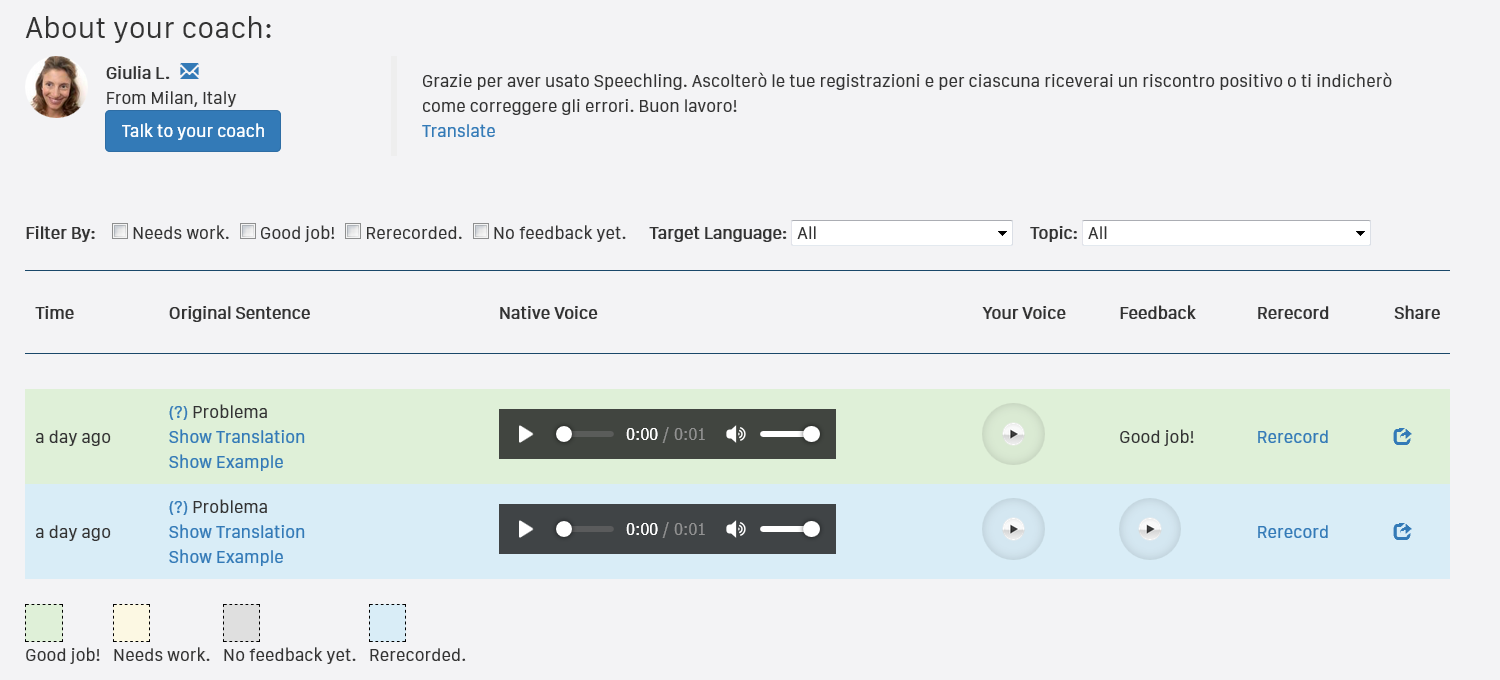
For the first feedback, I fed the machine with the pronunciation… of a different word, namely probabile (MP3). The next day, the feedback was an audio recording (MP3) saying this (in a monotonous voice that is partially unclear): “Esercizio consiste nel ???? la parola in italiano che hai ascoltato. In questo caso, problema.” First thing: the word marked “???” is neither ripetere, nor something else that would have made sense. The quality of the recording is pathetically low, and there’s no text that could be translated to the learner. Then, what’s said is not correct anyway, as it should have started with the definite article, i.e. “L’esercizio consiste…“.
Then, I uploaded a distorted recording of the correct word (MP3); their algorithm somehow recognized the word, and the next day the feedback from “Giulia L.” was the text “Good job!” on light green background.
I then tried in French, with “Sophie K.”:

Here, instead of problème in French, I gave the system a feminine recording of the Italian word problema (MP3). The next day, here’s the audio feedback (MP3) on yellow background (meaning “Needs work”): it just says “Problème“! Err… did “Sophie K.” just repeat the correct pronunciation, or was she about to say, in broken French, “Exercice consiste en ??? le mot en français que tu as écouté ; dans ce cas, problème,” but the script failed to output the full audio file? I’ll never know.
What’s more than obvious is that Speechling does not offer coaching by real humans, but by stupid bots (is this the famous Artificial Intelligence praised by so many morons?). The feedback is either the printed text “Good job!”, or an audio recording that ranges from (the simplest case) a good quality recording merely repeating the correct pronunciation, to (the worst case) a poor quality recording that’s grammatically incorrect, that includes a word which cannot be identified and which is not an obvious, simple word, and this kind of recording is purposely of low quality to mask the way the words were glued together!
Paying that much for an automatically constructed audio feedback is ludicrous, especially as this is not clearly stated as such, but the customer is simply lied to! And some credulous people took it in good faith while reviewing Speechling!
I would say that the German coach (Nicole S.) gives more thorough feedback than the French one (Sophie K.). I used Speechling primarily for these 2 languages, so I cannot say for the others. (I did try out a few words for Spanish – which I have not learnt – for fun, and those came back ok.) I listed the names in case there are other coaches, just so we are clear.
For the wrong sentences, the German coach usually repeats the problematic word first, then reads the whole sentence again. This is very useful because I find that the intonation of some of the recordings are not how I would say them naturally, but what the coach gives is much better. Sometimes she also mentions what is wrong, like the vowel should be long not short.
For French, normally I get just the problematic word or portion of the sentence as feedback. Occasionally she does do a comparison, something like “You said this, try to say that“.
No, there are no other coaches. Yes, the feedback is shorter in French. Yes, you’re stupid not to have noticed that all the mentions about short or long vowels and the like are prefabricated answers; also, there’s no need for the “coach” to repeat the phrase, as each phrase is recorded in the Audio Dictionary in two voices, a male one and a female one, and they can be listened to ad nauseam. Well, for those too lazy to click again, the fact that “the coach repeats the phrase” is useful! (Jeesus, just how stupid can some people be?!) But obviously the available prerecorded “audio bricks” are not the same in all languages, hence the differences.
Bottom line: A language learning tool for those who are still looking for the best snake oil formula. From fraudsters, for the gullible™.∎

💡💡💡💡💡 Bonus: YouTube channels as helpers in learning a language. Only what came to my mind, in no particular order this time, otherwise there must be thousands of similar channels:
🇫🇷 For French:
- Parlez-vous FRENCH ? — great lessons, difficult to only suggest a few ones (but still: Les pronoms compléments d’objet direct et indirect en français (COD et COI); Y et EN – Les pronoms compléments en français (Partie 2); 20 Erreurs courantes en français à ne pas commettre; 14 Erreurs courantes en français à ne pas commettre)
- Français avec Pierre
- Français Authentique
- Comme une Française — extremely popular and a classic one, I cannot suggest specific videos, as Géraldine is typically great (or at least she used to)
- InnerFrench (although he lacks empathy or, as it’s the case with most French people, he can’t put himself in someone else’s shoes; e.g. take Ne dites pas «pas beaucoup»; while correct, he fails to see why a foreigner would say “pas beaucoup” instead of “pas grand-chose”: it’s because they literally translate in French “not much” or the equivalent in their language, and much translates in Romance languages to IT molto, ES mucho, PT muito, RO mult, FR beaucoup, but beaucoup replaced moult in the 14th century; while beaucoup is adverb-only in French, much can be adverb, adjective, or noun in AmEn, and adverb, determiner, or pronoun by the way it’s classified in BrEn; this being said, in negative forms, its translations are not correct in other languages either, e.g. in Italian one wouldn’t say “non molto” but “non [ho fatto] granché” or “niente di che”)
- Easy French (especially 6 tips that will help you speak French like a native | Easy French 104; 8 Colloquial French Expressions You Should Know | Super Easy French 81; Bizarre French Animal Related Idioms | Super Easy French 78)
🇩🇪 For German:
- Learn German – Deutsch für Euch (11 Small Tricks to Sound More German; You’re Using ‘GANZ GUT’ Wrong || Deutsch Für Euch 121; 10 MUST-KNOW German Words – Na, Jein, Genau… || Deutsch Für Euch 101; “Ich bin ein Berliner” – Even Donuts Are Complicated in German || Deutsch Für Euch 109; durch- | ambivalent prefixes || Deutsch Für Euch 110-1; um- | ambivalent prefixes || Deutsch Für Euch 110-2; über- | ambivalent prefixes || Deutsch Für Euch 110-3; be- | inseparable prefixes || Deutsch Für Euch 99-1; ent-, emp- | inseparable prefixes || Deutsch Für Euch 99-2; er- | inseparable prefixes || Deutsch Für Euch 99-3; ge- | inseparable prefixes || Deutsch Für Euch 99-4; hinter- | inseparable prefixes || Deutsch Für Euch 99-5; miss- | inseparable prefixes || Deutsch Für Euch 99-6; ver- | inseparable prefixes || Deutsch Für Euch 99-7; zer- | inseparable prefixes || Deutsch Für Euch 99-8)
- Easy German
- DontTrustTheRabbit
🇮🇹 For Italian:
- Learn Italian with Lucrezia
- Impara l’Italiano con Italiano Automatico
- Italian for everyone
- Easy Italian — with Katie Harris and Matteo Alabiso (15 Italian Phrases You Should Know | Easy Italian 40; 14 things you should NEVER DO in Italy | Easy Italian 30; 12 Amazing Italian Words That Don’t Exist in English | Easy Italian 61; 7 Words Italians Hate | Easy Italian 42; 6 Mistakes That Even Italians Make | Easy Italian 52; What does “magari” mean? | Easy Italian 32; What Does “Anzi” Mean? | Easy Italian 47; How to Use PROPRIO in Italian | Easy Italian 67; How to use INSOMMA in Italian | Easy Italian 36; How to Use “Infatti” in Italian | Easy Italian 59)
- LearnAmo — with Graziana Filomeno and Rocco Dabellonio (È facile IMPARARE l’italiano? Le 9 Parole ed Espressioni che TUTTI gli Stranieri SBAGLIANO sempre; When and How to Use NE in ITALIAN!; 20 Italian SET PHRASES that will Change the Way you Speak Italian; 10 Things Italians Say EVERYDAY! Learn Italian Expressions and Words with LearnAmo; 9 TRICKS to SPEAK ITALIAN like a NATIVE (you’ll finally stop sounding like a foreigner); Phrases that Make Italians ANGRY (never use them… unless you want to start a fight!); 7 Espressioni SCORTESI da EVITARE in italiano per NON offendere: Impara le Alternative Cortesi!; Cosa significa VABBÈ in italiano? NON è un SINONIMO della parola VA BENE (sebbene derivi da essa) — also as an article; ITALIAN GESTURES: How do I use them? What do they mean? Learn How to Speak Italian with your HANDS!; ITALIAN VOCABULARY TEST: 99% of people fail… and YOU? Learn how to Speak Italian like a NATIVE!; ITALIAN LISTENING TEST and PRACTICE: What’s your level? Can you understand Native Italian Speakers?; Italian PREPOSITION TEST! Do you believe that YOU CAN SPEAK Italian like a NATIVE? PROVE IT!; Italian Prepositions (di, a, da, in, con, su, per, tra, fra); ARTICULATED PREPOSITIONS in Italian (how and when to use them); The 26 Most Important Italian GRAMMAR RULES that EVERY Foreign Student must Know (final surprise); QUANTI tipi di CAFFÈ esistono in ITALIA? Tutti i nomi, le caratteristiche e i prezzi dei CAFFÈ!)
🚀 [2022 UPDATE] Playlists and further selections from Learn Amo:
►[PL] Impara l’italiano in pochi minuti!
►[PL] Tutti i Tempi e Modi VERBALI in italiano!
►[PL] Tutto sul congiuntivo italiano!
►[PL] Espressioni idiomatiche italiane
►[PL] Grammatica italiana livello principiante (A1 – A2)
►[PL] Grammatica italiana livello intermedio (B1 – B2)
►[PL] Grammatica italiana livello avanzato (C1 – C2)
►[PL] Espressioni italiane
►[PL] Test di ITALIANO: Qual è il Tuo LIVELLO?
► How to STOP TRANSLATING in your Head every Phrase and Start THINKING in ANOTHER LANGUAGE!
► 9 TRICKS to SPEAK ITALIAN like a NATIVE (you’ll finally stop sounding like a foreigner)
► 15 COSE che NON ti permettono di PARLARE e SCRIVERE in ITALIANO come i MADRELINGUA (ho la soluzione)
► ITALIAN GESTURES: How do I use them? What do they mean? Learn How to Speak Italian with your HANDS!
- Vaporetto Italiano – Learn Italian with Francesco
- “Marco in a BOX”– only this selection: 20 Italian FALSE FRIENDS not to be trusted…; HOW TO BE ITALIAN • 20 Rules Italians never break; How to talk with your hands • 60 Italian HAND GESTURES; CAZZO!? Swear like an Italian! • 30 uses of Italy’s favorite bad word; ITALIAN WORDS you’ve been getting wrong…; ITALIAN PROVERBS • Can you guess these 15 popular Italian sayings?
- 🚀 [2022 UPDATE] Learn Italian with Teacher Stefano (Stefano Chiaromonte) — he’s very prolific, with videos both in Italian (with English subtitles) and in English, most often with related blog posts, so I’m only going to give you a quick selection of some playlists, and a few extra videos:
►[PL] Italian Prepositions
►[PL] Grammatica italiana
►[PL] Italian grammar in ENG
►[PL] Grammatica in italiano on the blog
►[PL] Grammatica in ENG on the blog
►[PL] Congiuntivo italiano
►[PL] Parole ed espressioni utili!
► Test A2 Italiano: test completo + conversazione
► Test B1 Italiano: test completo + conversazione
► Test di ASCOLTO in Italiano: La mia vacanza a Roma (+ trascrizione) - 🚀 [2023 UPDATE] From Metatron’s Academy (an Italian in America):
► Can You Tell Southern and Northern Italians Apart? Accent Guide
► Tuscan VS Standard Italian: Is Tuscan The Same as Standard?
► Standard Italians VS Regional “Dialects”
► Italian Words People ALWAYS Get Wrong!
► Can A Sicilian Understand Neapolitan?
► Can An Italian Understand Sardinian? Southern Italian, Sicilian
► Spanish VS Italian: Which is Harder? — I had a comment here: “With all due respect, there are differences you don’t mention. Il televisore ALWAYS refers to l’apparecchio, whereas la televisione has three meanings: 1. the concept, the system. 2. the TV organization, programs, broadcast, etc. 3. il televisore. Italian matches the French perfectly. In French, they have: le téléviseur (le poste récepteur de télévision): almost nobody’s using it, but when they do, it’s always about the device, the apparatus. And la télévision: three meanings: 1. the concept of television; 2. the TV organization, programs, broadcast, etc. (la télévision par câble, chaînes de la télévision); 3. le poste récepteur de télévision (short: la télé). ■ EDIT: Oh, my take as a native Romanian who also speaks French: Italian and Spanish are similar in complexity. At least, they don’t have 3 grammatical genders, like in Romanian or in German! They both use the subjunctive much more than in Romanian; however, the Italian grammar feels more consistent, and closer to Romanian’s (try to explain to a French or to a Spaniard what a predicate is; they stick to the verb having the function of a… verb, not of a predicate!).” Now, two relevant comments from others.
The first one: Actually in Spanish also exists the doublet “el televisor” and “la televisión”, which refering to the device is more a matter of local dialect (I would say that at least in Latin America “televisión” is more common), but the broadcasting per se is always refered as “la televisión”. Also, it can be shortened colloquially as “la tele”, but I’ve never heard “el tele”. And the article thing before names is made in colloquial Spanish all the time, it’s just the formal “rules” that prescribe against it.
As a native Spanish-speaker and with my modest knowledge of Italian (I mean, I can read it perfectly and somewhat understand it when I hear it, but not speaking it at all), I would say that grammatically Italian is objectively harder than Spanish —but, as you say, not so much harder— because it retains a pair of features lost in modern Spanish (although sometimes still present in Early Modern Spanish: the alternation of “essere” and “avere” as auxiliaries for the past tense, for example, or the gender concordance with the participle: Italian “ti ha chiamato/chiamata, vs Spanish “me ha llamado” regardless of gender. Italian “egli è partito” & “ella è partita” vs Spanish “él/ella ha partido”). But I would say that Spanish should be harder vocabulary-wise, if only because of the wider distribution (I mean, for example, you know the standard word for “popcorn”, wich is “palomitas de maíz” but you may never call it like that, you call it by the local name while being somewhat aware that in other places it is called different: “rosetas”, “pochoclo”, “crispetas”, etc.).
The second one: As a native English speaker having learned both Italian and Spanish to a high level, I’d say Spanish is a bit harder for English speakers. A few reasons:
-Lexically, Italian shares a bit (really only a bit) more vocab with English, simply because most romance vocab borrowed into English is from French, and French and Italian are lexically closer than French and Spanish. There also seems to be more words and expressions that can be translated literally between English and Italian than between English and Spanish (e.g. ‘to become’).
-In Italian, you can get away with not using the passato remoto in speech. In Spanish you really need to be able to actively produce the preterite (equivalent forms to Italian passato remoto), the perfect (equivalent to passato prossimo) and the imperfect (same as Italian).
-The subjunctive in Italian should be learned if you want to speak in a standard way, but it’s mostly superfluous and you can communicate without it. It’s basically just an extra set of forms that need to be used in a fairly straightforward way in some contexts. In Spanish you cannot communicate fully without the subjunctive. For instance, at one point I, intending the phrase “Let me know when you do it”, said to a Spaniard “dime cuando lo haces” which in reality means “tell me when it is that you do it”, as opposed to “dime cuando lo hagas” which communicates the intended meaning. Spanish also doesn’t merge the 3rd person plural subjunctive with the indicative like Italian, meaning you have to distinguish “decimos” (we say) from “digamos” (let’s say). It also uses the subjunctive for the negative imperative, while Italian just uses the infinitive.
Obviously you can point to things that are harder about Italian… the passato prossimo is a little more annoying to form than the Spanish perfect with two auxiliary verbs and more irregular participles… but there are also other things I didn’t mention above in Spanish, like stressed/unstressed vowel deformations.
► Can An Italian Understand ARGENTINIAN Spanish? This BLEW My Mind!
► Can An Italian Understand Romanian?
🇪🇸 For Spanish (Spain, not Latin America):
🇬🇧 For British English (specifically non-American):
- English with Lucy (e.g. STOP confusing these words! Especially or Specially? Assure or Ensure? Inquire or Enquire?; You MUST NOT confuse these words! Luggage or Baggage? Complex or complicated? Beside or Besides?; AMERICAN vs. BRITISH expressions & phrases – we won’t understand!; 50 COMMON ENGLISH PHRASES TO USE IN CONVERSATION; DO NOT say “you’re welcome”! Respond to “thank you” PROPERLY!; British Humour Explained (with examples); 7 ‘polite’ British insult idioms | Politely call someone a total idiot!; 20 Stunningly Beautiful English Idioms; The 7 Words Almost ALL English Learners Use INCORRECTLY (and many native speakers too!); Well hello darling…16 classic British English phrases to make you sound exceedingly posh & fancy; 5 “Grammar Rules” (myths) your teachers HAVE BEEN LYING about!)
- ETJ English (e.g. The Intrusive /r/ and Linking /r/ – British English Pronunciation & Connected Speech)
- English with Greg (e.g. PRESENT PERFECT or PAST SIMPLE? Learn The Difference and Avoid This Mistake!; EXPLAINED! Past Continuous and Past Perfect Continuous Tenses; Using Intrusive R and Linking R to Understand British English | Connected Speech; Linking j Sound in English; Linking W Sound in Connected Speech)
- Arnel’s Everyday English (e.g. ALL CONDITIONALS | 0,1,2,3 and MIXED CONDITIONALS – English Grammar | if….; PRESENT PERFECT or PRESENT PERFECT CONTINUOUS? | the difference)
Obviously, there is a tremendous number of YouTube channels that might help you learn or improve a language, but you’ll need to find them in the huge pile of crap that is YouTube. Some or them are only spoken in the target language by natives (with or without subtitles in English, in the target language, or in both); some are spoken in English, or the host explains in English what they said in the target language; finally, you should be able to find people speaking your language, oftentimes fellow citizen of yours, who explain how they learned a language, and offer you tips, tricks, and lessons. There are also polyglots who can offer tricks about several languages, sometimes explained in more than one language.
YouTube is a curse and a godsend in one. In regard to language channels, not everything said in such videos is 100% accurate, especially when you’re told what not to do–examples: “don’t use Duolingo, because it doesn’t contain grammar” (it does, at least for a few language pairs); “I had to investigate on my own the usage of ci in Italian” (even Memrise specifically covers the subject!); “don’t try to learn a language by watching movies in the target language” or the opposite “the next step is to watch Netflix in the target language” (my take is that once you understand at least 50-60% of what’s said in a film, you’d gain enormously by watching it, as it’ll help you retain words in context, and even figure out new meanings and unknown words). As the Americans say, YMMV, but there are tons of useful videos on YT, especially those made by natives of your target language, and especially those who explain the cultural context and various practicalities.
An example: say you’re an Italian learning English. Since John Peter Sloan is no longer with us, you’ll have to resort to JoEnglish, who took inspiration from JPS and thanked him in a short video obituary. You see, John Peter Sloan was right: total immersion in a language is wrong for those not advanced enough, and “classical” explanation in the student’s language is necessary. JPS was far from “classical” though, he was really a pioneer in developing methods of teaching English. A few of JoEnglish’s videos I really liked, for they’re so well explained:
- BASTA! Non dire più ‘ME TOO’!! ‘Anche io’ si dice cosi… (Hint: say “So do I!”)
- Il Futuro – Non DEVI usare sempre WILL!! Impara ad usare bene il futuro! (The Future: 1. Be going to. 2. Present Continuous. 3. Present Simple. 4. Will.)
- Past Simple V Present Perfect? FINALMENTE una spiegazione CHIARA!! (Greg also has an equivalent video, linked to above)
- Present Perfect Continuous – SPIEGATO BENE!! FACILE!! (again, compare to Greg’s, which is not bad either)
- BASTA! Non dire più YOU’RE WELCOME! Parla come UN INGLESE! (here you should compare to Lucy’s)
This being said, I believe that one cannot learn a language only by the means of one or more YouTube channels or, if they can, they need to use a dull channel that includes filmed old-style lessons, à la Learn English with Gill (engVid). I’d rather use a combination of printed books and one or more apps, and only then I’d complement them with YouTube videos!
Note that even native people, and even professional teachers, can sometimes seem shallow or not thorough enough in such videos. These are not books, meaning they’re not reviewed, corrected, revised, etc. Also, native people don’t necessarily understand why non-natives make certain mistakes (see my comment to InnerFrench), and what is it that’s the most difficult for them (for English with Lucy, I linked to a video on 10 pairs of words not to be confused, the one including “luggage vs baggage”; well, she missed “advice vs advise”; then, in the video about the 20 words you might pronounce incorrectly, many are a non-issue, such as rural, prelude, juror, spherical, pronunciation, and even squirrel is only an issue to French people, whereas missing important difficulties, such as “There is no witch in Greenwich.”; Leicester; colonel pronounced as kernel; gauge). This is why even for printed manuals & methods I’d favor those targeting learners coming from a specific language & culture. At least until the B1+ level, it’s impossible to properly teach German or English with a unique approach, i.e. the same way e.g. to Arab students and to Romance languages students; you’d miss the difficulties that are specific to given language pairs (maybe a student’s mother tongue doesn’t have noun genders, or maybe specific verb tenses or moods are used differently). Heck, even Italian poses specific problems to native speakers of Spanish, and they’re sister languages! (There’s a video about that, one of Graziana’s that I linked to.)

More resources and ideas on All Language Resources. This doesn’t mean I agree with them very often, but their review of Assimil is fair and positive (4/5).
Another site dedicated to languages, The Mezzofanti Guild, features reviews of language learning methods. Unfortunately, their review of Assimil is the supreme proof of the idiocy of our contemporaries.
The reviewer is an idiot, no matter a graduate in Applied Linguistics.
The current fucking trends say the student isn’t supposed to be told and taught the grammar rules, and sometimes not even the translations of the words! You see, they have to “discover” them. But everyone who was schooled before 1990 (in Europe) was taught “the traditional way”–and there’s nothing wrong with that. The major mistake of all these new methods is that they try to make an adult learn the way an infant and a kid learn their mother tongue, which is totally impossible. By the time a child reaches the school age and is told what grammar is, (s)he’s been exposed to billions of times (s)he heard words in that language, and this phenomenon is unrepeatable, not to mention that whatever you learn at that age sticks in a way that, again, cannot be repeated at a later age!
Like most methods designed before 1990. The world didn’t suddenly work better since the 1990s and the new, “innovative” approaches.
Of course, the world was all wrong for so many decades, if not centuries! I suppose the Cardinal Giuseppe Gasparo Mezzofanti (1774–1849), said to have spoken 39 languages fluently and the spiritual patron of the site that trashes Assimil, must have learned those 39 languages using a method based on lots of peer-reviewed studies, right?
Maybe an Australian simply doesn’t understand how life is (or used to be) in Europe.
OK, I guess that was the last time I needed to change and rearrange the mini-reviews. I hope I didn’t screw up anything. Moving along…
I exposed Speechling for the fraud that it is.
I expanded the section on YouTube channels as helpers in learning a language (at the end, after the picture with a cat on it).
The wise person has long ears and a short tongue.
Hi Beranger,
Thanks for this great account of language learning apps! As I spend a lot of time in the commute, these apps have become one of my favorite passtime! Concerning the online web based courses, the best I found for German are:
– Nico’s Weg from DW
– deutsch.info
– vhs-lernportal.de
The plus: all of them are free! They teach grammar and vocabulary in a sensible way, with lots of practice exercises.
Talking about apps, Wlingua Spanish and Russian courses are pretty good (available from the Google playstore), far better than Lingodeer.
But, as you, I personally prefer textbooks with hundreds of practice exercises (think Spektrum Deutsch or the ASSIMIL workbooks for many languages – there usually come in three flavours: débutants, faux-débutants and intermédiaire. We can only take so much grammar in terms of sets of rules and exceptions, but with enough practice it becomes second nature.
I also use Anki, the king of SRS, but only to drill sentences. For vocabulary I find Quizlet works better: they dropped the SRS a year ago and it’s all for the better – SRS tend to become a burden after accumulation of several thousands of words, I hate spending my day reviewing them.
Take care,
Marin
Ne me dites pas que vous êtes toujours en vie, Monsieur ! (Et intéressé par l’allemand, en sus. Je ne comprends pas pourquoi tant de Français, Italiens, etc., etc. lorgnent l’Allemagne comme qui dirait « ca musca la căcat ».)
vhs-Lernportal has an app too.
Eh oui, toujours en vie, et il m’arrive même de lire de temps en temps le site/blog de l’ex Berangér 🙂 Comment j’ai commencé à m’intéresser à l’allemand ? Au fait, il y a quelques années j’ai commencé à prendre des cours de chinois : intéressant mais dur, dur ! Après trois ans, et un niveau à peu près HSK3, j’en avais un peu marre, je me suis alors dit qu’il fallait que j’essaie une autre langue pour changer des idées. L’espagnol, l’italien : trop simple pour quelqu’un qui parle déjà deux langues latines ! Je suis tombé par hasard sur un texte en allemand et là, sans rigoler, je ne comprenais pas un seul traître mot. Combiné avec le fait que l’allemand est réputé une langue moche (tout comme le chinois), je me suis dit qu’il fallait impérativement que je vois ça de plus près !
Sinon, l’app vhs-Lernportal est okay, mais on ne peut pas copier/coller les mots (pour chercher dans un dictionnaire par exemple), donc pour moi c’est un grand non-non. Le site web, par contre, marche très bien sur mon téléphone, donc l’app ne me manque pas trop. Mon but avec l’allemand c’est de pouvoir lire et consommer des médias, pas de parler ou écrire (bc plus difficile à atteindre un bon niveau), et là j’ai honte de le dire mais j’ai un meilleur niveau en allemand qu’en chinois (A2 -> B1) !
A+, Marin
Certo, l’italiano e lo spagnolo sono più facili (attenzione ai falsi amici però!), ma lo scopo principale dell’apprendimento di una lingua non è quello di soddisfare una sfida, ma di poter leggere e ascoltare più contenuti in quella lingua, di avere un’esperienza non mediata della lingua e della cultura rispettiva, di leggere libri che non sono mai stati tradotti, film, ecc. (comme vous l’avez bien dit, de lire et consommer des médias).
Sfortunatamente, non mi trovo bene con la lingua e la cultura tedesca, tutto mi sembra ancora strano, innaturale, senz’anima, alieno.
RE: The community-made courses on Memrise, I’ve noticed you can open a web-only community course in the app once you’ve completed an exercise for this course on the website.
CNN, the apex of the American idiocy, on April 2: in We tried the top online learning platforms — here’s how they compare, they found Babbel to be the winner in the “Best online language courses for beginners” category, and Rosetta Stone the winner of… “Most in-depth language courses”!
To find any depth in Rosetta Stone, one must be the supreme idiot.
Follow-up, almost 20 months later: Language Learning Apps and YT Channels: Season 3.
A small [2023 UPDATE] for Italian YT channels.
Quick updates for Italian and Spanish, YT channels:
●●● Joy of Languages. Italian, which is a strange channel, as it features among its teachers Katie Harris and Matteo Alabiso from Easy Italian, but many others too, from which I like Stefano:
●●● Linguriosa: 🦖Canal para los pedantes del español.
I wanted to add a note to this post regarding the YT channel Joy of Languages. Italian, because Katie Harris and Matteo Alabiso from Easy Italian seem to have started to post again to this channel. There still aren’t many videos, but YT just suggested that I should watch The Most Common Italian Curse Words (That Italians Actually Use!).
Obviously, they only covered some “parolacce” (a 2nd video should be created at some point), but there are more of them here: Commonly Used Italian Curse Words and Insults.
I always appreciate the ability to swear in a language.